Journalists are eligible for free email subscriptions to SEJournal, including TipSheet, WatchDog (on access issues) and more.
Multimedia
conference coverage
| Agenda | Coverage | Exhibitors | Lodging/Transportation | Español | About Miami |
SEJ's 21st annual conference, October 19-23, 2011, was hosted by the University of Miami. Below you will find multimedia coverage provided by SEJ, volunteers and conference attendees. For other coverage, see also:
- SEJ 2011 Unofficial Conference Blog with posts by conference attendees. RSS feed.
- Cubrimiento en Español.
- Public SEJ Miami 2011 Flickr conference photo group, where you can upload/share your own conference photos (thanks to SEJ member Christine Woodside!).
- Find attendee posts on twitter: search #sejmiami
-
The Miami Planet is an online newspaper from University of Miami's Knight Center for International Media and its School of Communication in collaboration with Florida International University and Miami Dade College. The Planet is being devoted to reporting the highlights of the SEJ Miami conference and publishing scores of stories on South Florida and its environment. RSS feed.
- If you attended the Conference, please take a few minutes to tell us how we did. What you think matters to us and your feedback helps SEJ make future conferences more valuable. Click here to take our online survey.
Thank you to all our volunteer writers, recorders and photographers — we couldn't do this without you.
 |
|
Clyde Butcher and Secretary of Interior Ken Salazar at the Everglades Restoration Tamiami Trail Bridge prior to the Swamp Slog tour. © Photo by Clyde Butcher Photography. |
NOTE: It's critically important to SEJ to gather evidence on the impact of our work. Please help us to keep SEJ strong and share links, photos, copies of reporting generated or informed by this conference! Thanks!!! Contact Cindy MacDonald, SEJ's Web content manager.
Page Menu
Wednesday, October 19
Thursday, October 20
Friday, October 21
Saturday, October 22
Sunday, October 23
Miscellaneous conference coverage
Pre-conference Miami and area environmental stories
Wednesday, October 19
Opening Reception and Dinner at the InterContinental Miami
- "Rain Washes Out Talk of Sun, Sunglasses (A First: Delegation From Latin America)," The Miami Planet, October 19, 2011, by Jacqui Goddard.
- "Salazar Calls for Coverage," The Observatory blog, Columbia Journalism Review, October 25, 2011, by Curtis Brainard (this story reports on both Salazar's and Hiaasen's remarks).
- Session description and speakers.
Secretary of the Interior Ken Salazar
- Audio file (MP3/00:40:41).
- "SEJ: Ken Salazar Ignores Global Warming," Think Progress, October 19, 2011, by Brad Johnson.
- "Transcript of Ken Salazar's speech at Society [of] Environmental Journalists’ 21st Annual Conference," U.S. Department of the Interior, October 19, 2011.
- Session description.
- Audio file (MP3/00:33:00).
- "Carl Hiaasen Endorses Occupy Wall Street," Think Progress, October 19, 2011, by Brad Johnson.
- Session description.
- Audio file (MP3/00:12:25).
- "Climate Change Causing Decline in Antarctic Penguin Population, Says Researcher," Earth Island Journal, October 20, 2011, by Maureen Nandini Mitra.
- Session description.
- Audio file (MP3/01:08:53).
- "Cousteau Family Makes Historic Appearance," with SEJ Miami co-chair Jeff Burnside of NBC Miami, October 20, 2011.
- "Jacques Cousteau's Granddaughter: Ocean Exploration Is 'This Generation's Space Race'," OurAmazingPlanet, October 21, 2011, by Brett Israel.
- Session description. Photos.
Thursday, October 20
Tour 2: Tag Wild Sharks with Your Bare Hands
- "Shark Tagging with RJD & SEJ," R.J. Dunlap Marine Conservation, University of Miami, October 25, 2011; video by Christine Shepard.
- "Scenes from a Florida Shark-tagging Expedition," The Washington Post, October 25, 2011.
- "Shark conservation is gaining momentum — but are we doing enough?," The Guardian, October 27, 2011, by Suzanne Goldenberg.
- Session description and speakers.
Tour 3: Big Sugar, Big Cleanup, Big Lake: The Sugar Industry, the Everglades Cleanup and Lake Okeechobee
- "How Crony Capitalism Dominates the Sugar Business," GreenBiz.com, October 25, 2011, by Marc Gunther.
- Session description and speakers.
Tour 4: Everglades National Park: Pythons, Gators and Billions for Restoration
|
Mournful Sphinx. © Photo by Jim Poyser. |
- "Slideshow: A Trip to the Everglades," NUVO, October 25, 2011, by Jim Poyser.
- Session description and speakers.
Tour 5: Gone Fishing: Sportfishing, Tourism and the Challenges of Protecting Fish Stocks
- "Sounds fishy: A true tale about the economics of the environment," Switchboard blog, Natural Resources Defense Council, October 26, 2011, by Bob Keefe.
- Session description and speakers.
Tour 6: A Swamp Slog with Clyde Butcher
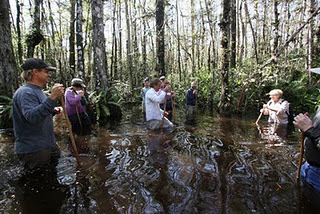 |
|
Swamp slogging at Big Cypress. |
- "Tromp Through Big Cypress Swamp Shows Soggy Paradise," The Miami Planet, October 20, 2011, by Craig Pittman, St. Petersburg Times.
- "New Feud Erupts Over Big Cypress Preserve," St. Petersburg Times, October 22, 2011, by Craig Pittman.
- "Tamiami Trail Bridge Restores Flow to Everglades, But It Won't Be Enough," St. Petersburg Times, October 25, 2011, by Craig Pittman.
- "Task force expected to unveil plan to fast-track Everglades restoration," The Florida Independent, October 28, 2011, by Virginia Chamlee.
- Adventure Tour with Society of Environmental Journalists, Clyde Butcher's Photo Journal blog, October 29, 2011 (lots of great photographs!).
- Session description and speakers.
Tour 7: Island Sun, Trashy Electricity and a Whole Lotta Atoms in Between
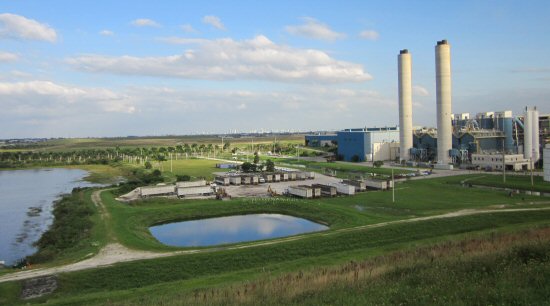 |
|
Covanta's waste-to-energy plant. © Photo by Chuck Quirmbach. |
- "Energy Tour: Looking Over Nuclear Power (From Well Outside)," SEJ 2011 Unofficial Conference Blog, October 20, 2011, by Peter Fairley.
- "Kewaunee Nuclear Plant Sale Attracts a Few Inquiries," Wisconsin Public Radio, October 31, 2011, by Chuck Quirmbach.
- Session description and speakers.
Tour 9: Eye of the Hurricane: The National Hurricane Center and the New "Wall of Wind"
- "NASA Launches NPP Polar Orbiter — But Are Future Studies in Doubt?," Popular Mechanics, October 28, 2011, by Steve Rousseau.
- Session description and speakers.
Photography As Environmental Journalism
- "A Photographic Call to Action," Green blog, The New York Times, October 25, 2011, by Rachel Nuwer.
- Session description and speakers.
Friday, October 21
Breakfast Plenary — Communicating Science: Reporters Go Head to Head with Top Ocean Scientists
- Audio file (MP3/01:05:57).
- "NOAA Chief: The Climate Crisis the Media is Missing," Climate Watch blog, KQED News, October 21, 2011, by Gretchen Weber.
- "Jane Lubchenco Exclusive: 'We Don't Fully Understand The Consequences' of Drilling the Arctic," Think Progress, October 25, 2011, by Brad Johnson (includes a video interview with Lubchenco).
- Session description and speakers.
Opening Plenary — Fish Fight
- Audio file (MP3/01:33:28).
- "Fish Fight," Watchdog Earth blog, Louisville Courier-Journal, October 21, 2011, by James Bruggers.
- Session description and speakers.
Concurrent Sessions 1: THE CRAFT: Freelance Pitch Slam
- "Climate Change May Boost a Lethal Disease," The Daily Climate, November 29, 2011, by Nancy Bazilchuk (pitched during the slam).
- Session description and speakers.
Concurrent Sessions 1: LATIN AMERICA: Connecting the Mining Frontier and the Corporate Hometown
The Mining Front: Local Versus Corporate
By KATIE GUEST, University of Miami
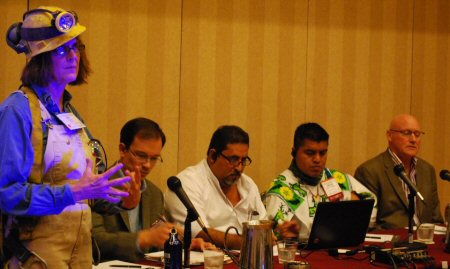 |
|
L-R: moderator Talli Nauman, Keith Slack, Francisco Pineda, Santos de la Cruz Carillo, and Anthony Hodge. © Photo by Katie Guest. |
As corporations began to realize that leaving communities with empty mines and dead land that was once healthy is unacceptable by today’s standards of corporate responsibility, the situation in South America has begun to change. In the past 20 years there has been improvement by mining companies in the involvement of local and native people in respect to planning and co-operation for environmental protection.
Francisco Pineda, founder of Cabanas Environmental Committee and 2011 Goldman Environmental Prize recipient, told an audience at the SEJ conference on Friday morning that the problem continues despite improvements. "They told us we would have a better life, but mining touches every bit of our culture and society and it is not friendly to the environment or the community," he stated.
Will mining operations in South America consistently take the natural and unharmed environment into consideration when building as well as removing mines?
Pineda and other panelists from international mining corporations, representatives from countries hosting mines in South America, and awareness advocates discussed the future of mining and its ecological impact. In the past, both large and small mining companies have essentially decided upon a new location for a mine and merely planted it where it is most beneficial financially for the company. Once the mine was depleted, the company abandoned it and locals were told they would receive benefits if no conflict was raised over the land.
"The new and upcoming considerations that all corporations must make involve the financial, ecological and social effects that building a mine will have on both the host country as well as the company," said Anthony Hodge, president of International Council on Mining and Metals. "There are already examples of very successful developments in British Columbia, Canada that have had positive involvement of both fronts that concluded in a currently harmonious and beneficial project."
The panel concluded with a question-and-answer period in which past examples were used to discuss future plans and the areas of improvement that corporations still have yet to make.
Overall, it can be seen that with both groups working together, the metal mining industry is making forward steps for the environment.
- Audio file (MP3/01:42:45).
- "Indigenous People Fight Mining Industry," Wisconsin Public Radio, October 28, 2011, by Chuck Quirmbach.
- Session description and speakers.
Concurrent Sessions 1: THE OCEAN: The BP Spill and the New Future of Offshore Drilling
What We're Learning from the BP Oil Spill
By CHRIS WITTYNGHAM, University of Miami
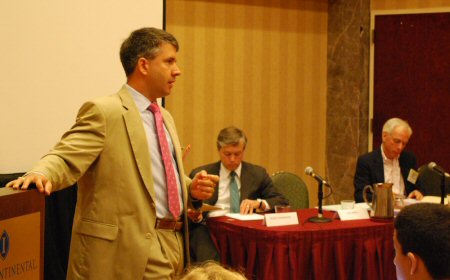 |
|
L-R: Erik Milito, Walter Cruickshank, Elgie Holstein. © Photo by Katie Guest. |
The BP oil spill was not a freak accident, Elgie Holstein, senior director for Strategic Planning at the Environmental Defense Fund, said at Friday morning's session at the SEJ Conference in Miami. Holstein insisted that the spill revealed a need for stronger regulation at the government and industry levels.
"This was not just a couple of operators who were asleep at the switch," said Holstein. "There were widespread cultural problems and managerial problems and they are not confined to BP."
Walter Cruickshank, deputy director of the Bureau of Ocean Energy Management, who was also on the panel, detailed changes that have been made and are continuing to be implemented.
"One of the fundamental weaknesses in this effort was that MMS (Mineral Management Service) had three large and competing missions," said Cruickshank.
MMS is now divided into departments of energy development, environmental enforcement and environmental protection. BOEM, the Bureau of Ocean Management, and BSEE, the Bureau of Safety and Environmental Enforcement, are now part of the U.S. Department of Interior.
Holstein also submitted several misconceptions about the spill and its consequences. Holstein presented that new, more stringent regulations would not raise operating costs on drilling and also suggested that the government and industry officials were reacting during the crisis and ultimately didn't know the next step.
Holstein also issued a warning about the direction of oil drilling in the Arctic.
"The biggest challenge looking forward is what's going to happen in the Arctic," said Holstein. "If we design a whole bunch of response protocols that are focused on what we've learned in the Gulf of Mexico, I can pretty well assure you that we will have failed the test of preparing for the challenges we will face in the Arctic."
The session became contentious when reporters in the audience pressed Erik Milito, upstream operations director at the American Petroleum Institute, who defended his industry's practices.
"We're creating documents that are effective and, in many cases, robust that can be utilized in the regulatory framework," said Milito. However, the measures that have been enacted have been mostly a reaction to the aftermath of the BP oil spill, but the panelists also talked about the future and how to be proactive in reducing risk for future projects. "What we do is try to manage risk and reduce it to a level where the public at large is willing to accept a level of risk in return for the benefits of the activity," said Cruickshank.
- Audio file (MP3/01:10:51).
- "Obama Administration Approves BP's Plan To Drill in the Gulf of Mexico," The Florida Independent, October 25, 2011, by Virginia Chamlee.
- Session description and speakers.
Concurrent Sessions 1: THE NATION: Pollution Politics: Conservatives Attack Conservation, GOP Looks To Gouge Environmental Budgets
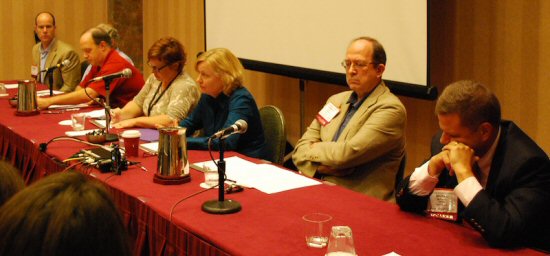 |
|
© Photo by Katie Guest. |
Conservatives Attacking Conservationists
By IVANA CRUZ, University of Miami
Recent attempts by conservatives to roll back U.S. Environmental Protection Agency regulations were the center of attention for a group of national pollution and politics session panelists at the Society of Environmental Journalists conference on Friday.
"It's like Willie Sutton when he was asked why he robbed banks. What did he say? 'Cause that's where the money is.' Here and now, because the rules are here and now. If you look at EPA regulatory streams, for a variety of reasons, it all comes together here in the last year," said panelist Mike McKenna, president of MWR Strategies.
The Republicans' attacks on regulatory actions such as those concerning greenhouse gasses and coal ash are thought to be the largest rally against environmental protection regulation in the nation's history. The necessity of these rules and their budgeting are being put to questioning. "The rules that EPA is undertaking, and they are many, and they are important, and they are environmentally and economically consequential; those rules are require by law," said panelist Lisa Heinzerling, professor of law at Georgetown University.
In order for the GOP to find results in its attempts, it must change the laws overseeing the EPA. The EPA runs its regulations based on scientific proof, meaning scientific proof must be given for change to occur. According to panelist David Goldston, director of Government Affairs for Natural Resources Defense Council, this is what the Republicans are trying to do by going after rules as a way to hide their intentions to change the law. "Polling shows that hardcore and anti-government libertarian types, who tend to oppose governmental safeguards, represent somewhere between 15 and 20 percent of Republican voters," said panelist David Jenkins, government affairs director for Republicans for Environmental Protection. These Republicans fighting regulations are those with special interests, added Jenkins.
Panelist Steven Brown, executive director for the Environmental Council of the States, argued that the main problem with the issue is not the transfer of budgeting desire by those against EPA regulations.
Instead, it is the lack of the funding there is for the states to implement these regulations. There has been an average of 50 new environmental rules made each year since 2004 and a steady decline in budgeting to do so. "We are living through the largest congressional assault on our air and on our water in our country's history. The other reason why this is happening is because we are making progress. Under the Obama Administration, we've seen dramatic regulation to increase fuel economy and reduce fuel emissions on automobiles, cars, and trucks," said panelist Michael Brune, executive director of the Sierra Club.
- Audio file (MP3/01:18:14).
- "Sierra Club’s Brune: We’re Stopping Coal," by Marc Gunther, October 23, 2011.
- "Science and the Law: Leave EPA To Do Its Job," UnEarthed blog, Earthjustice, October 25, 2011, by Raviya Ismail.
- Session description and speakers.
Concurrent Sessions 1: ENERGY AND CLIMATE CHANGE: Climate Change As a Cultural Issue
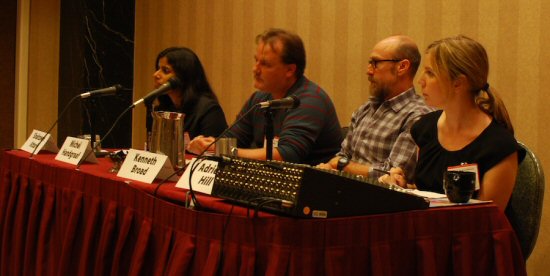 |
|
© Photo by Katie Guest. |
Framing Climate Change Information Key to Getting Public's Attention
By KIMBERLY SEARS, University of Miami
Panelists Shahzeen Attari, Dr. Michel Handgraaf and Kenneth Broad each firmly agreed that framing the information about climate change would help Americans understand how our world is changing.
In order to get the attention of the public about these issues, scientists and media need to frame the perception based on the different people in the world.
The panelists, moderated by Adriene Hill, multimedia reporter for Marketplace, spoke to an audience Friday at SEJ about how American society perceives global warming and ways to frame the minds of audiences to think about the climate change that is happening.
The idea, they said, is to use an image that citizens can relate to, which in turn, will help them understand how the climate is changing and what can be done about it.
Dr. Michel Handgraaf, associate professor of economics of consumers and households at Wageningen University in The Netherlands, discussed the norms of society and how people tend to follow the trends of norms whether they are useful or not. "To convince people, you need to know who they are," said Handgraaf. A frame is never the same for people if you want to convince them.
Shahzeen Attari, assistant professor at the School of Public and Environmental Affairs at Indiana University, believes that in order to prove the impact of the climate change it needs to be visible to the audience. "We need frames that can impact that individual that the individual can relate to," Attari explains. "To refine these frames problems... that will adapt to the audience and frames that are physical to your audience."
Kenneth Broad, director of the Abess Center for Ecosystem Science and Policy at University of Miami and co-director at Center for Research on Environmental Decisions, Earth Institute at Columbia University, explained that what makes it difficult to improve perceptions about climate change is the uncertainty of the matter.
Broad discussed that it is difficult to explain an event such as climate change and explain the risks to people since it is an event that has never happened before. He also makes a point that people tend to frame climate change with natural disasters.
"Floridians frame that the impact of climate change will increase the amount of hurricanes, which could not be more wrong," Broad said.
All three panelists agreed that, in order to change the frame of mind of Americans... the labels global warming and climate change have a negative connotation attached. Attari suggested that in order to ease their minds, it is helpful to tell people what they can do in order to reduce climate change. The panelists said conclusively that if people perceive the name of climate change differently, they will be more likely to help stop it from occurring.
- Audio file (MP3/01:10:07).
- Session description and speakers.
Concurrent Sessions 1: POLLUTION AND SOLUTIONS: Untold Environmental Success Stories in Industry and Government
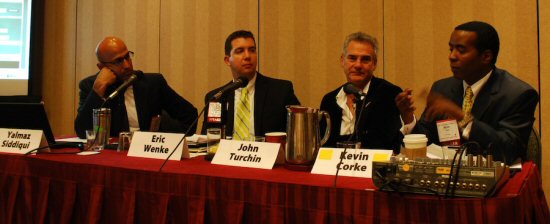 |
|
© Photo by Katie Guest. |
Talk About Opportunities, Not Just Problems
By BRANDON LUMISH, University of Miami
Journalists need to discuss the opportunities and not the problems, Yalmaz Siddiqui, director of Environmental Strategy for Home Depot, told members of SEJ at Friday morning's pollution session. He suggested that stories have a more positive look, such as company X did this to save money.
"Educate the market places as much as you can," said Siddiqui. Home Depot, a company trying to improve its environmental performance, has provided greener solutions at every level, Siddiqui said, and was recently ranked No. 8 in Newsweek's 2011 Green Rankings.
While it may not seem that way from media coverage, there are numerous environmental success stories within government and industry. This session was devoted to telling several of the untold success stories.
Baptist Health South Florida's hospitals are trying to make changes by going "green." This movement involves many different aspects of hospital operation. At Baptist's hospitals, there is so much waste that managers have made a strong push to go as green as possible.
Examples of this include waste management and recycling. By doubling recycling activity over the last two years, the hospitals have reduced medical waste by more than 50 percent. Foam cups in the dining room are now being made into non-degradable waste. The hospitals have implemented many programs such as these because they realize there is so much change that can be made to happen. "Never had as much technology to impact change," said Eric Wenke of Baptist Health South Florida.
Baptist Hospital began the movement to go green by first asking its 15,000 employees how they feel about what they are doing. Changes began and hospital officials started to jump on board.
"Once you have a core group, parties in the larger set will say that's very interesting and begin to make changes to follow the core group's environmental changes," said Wenke. The hospitals have re-evaluated how they are doing everything and are moving in the right direction.
Another quite different example involved a mountain resort. Making a resort self-sufficient is also a positive way to go green. John Turchin, a developer of Lodges in Eagles Nest, has done just that on a mountain in Banner Elk, N.C. He powers the whole community with solar power. "Every day, the sun comes up, that's the one guarantee," said Turchin. Turchin believes that every building in the United States could power itself which, after making the initial investment, would save the company a lot of money in the long run.
"Look at it like a farm; why not grow a power farm?" asked Turchin. Companies have become very interested in this idea because not only are they saving money, they are helping the environment at the same time. Panelists agreed that there is a need to keep the awareness growing about the multiple benefits, including economic, of implementing green practices and for media to highlight more success stories that have helped both the environment and the business.
- Audio file (MP3/01:10:23).
- Session description and speakers.
Concurrent Sessions 1: THE GLOBE: Plate-centric America: The Bottom Line is Social Good
 |
|
© Photo by Katie Guest. |
Our Direct Relationship with Food
By MARI CENTENO, University of Miami
Educating the public about the importance of eating organic and locally sustainable foods — and creating socially-just environments for farm workers — is critical to Americans' relationship with food, a group of expert panelists told an audience at the Society of Environmental Journalists meeting held Friday in Miami.
"We care about food and the flavor of food," said Helene York, director of Strategic Sourcing and Research for Bon Appetit Management Co., a food service company that supplies colleges, corporations and special events with sustainable foods.
"The reason for creating this company was to get rid of mystery meat."
York emphasized that everything in the food industry is connected. The use of antibiotics or antimicrobials in meat leads to the bad welfare practices that produce genetic diversities in the food systems and create bad food products that look and taste the same. This also creates terrible work conditions for the farm workers.
In previous times, many farm workers across the country worked under unpleasant environments and were treated unjustly. Leonel Perez, farmworker leader for the Coalition of Immokalee Workers, an organization which helps eliminate the exploitation that exists in farming fields, expanded on the plans to create just working environments for these people. The organization began in 1993 when the workers at the time were being treated with violence, not being paid for weeks' worth of work, and also getting sick due to the pesticides used in some of the farming.
Throughout the 1990s, they discovered the huge influence bigger corporations and organizations have on these farms.
To improve unfair situations, the Coalition of Immokalee Workers contacted bigger organizations, such as churches and schools to ask them where their tomatoes came from; however, these organizations didn't know. "They asked these corporations to pay more money for their tomatoes so the farm workers could get one cent increase for each pound of tomato they farmed, and establish a code of conduct that protected workers' rights," said Perez.
However, the good food system isn't just about what we are going to have on our plate or which grocery store we will get our food from. It's more about our direct relationship with the food.
"It's combining the cultural relationships and the production of the food that we need to think about," said Kolu Zigbi, program officer for Sustainable Agriculture and Food Systems and Jesse Smith Noyes Foundation in New York City.
- Audio file (MP3/01:12:04).
- Session description and speakers.
Concurrent Sessions 1: THE EXTRAS: Covering Disasters Without Becoming One
To Cover Disasters, Prepare for Anything, Everything
By ALYSSA KARAS, University of Miami
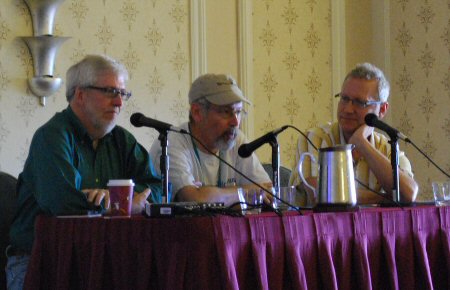 |
|
L-R: moderator Randy Loftis, Mark Schleifstein, and Michael Kodas. |
Ignoring evacuation warnings and common sense, journalists flock to disaster. Award-winning reporters Michael Kodas, Mark Schleifstein and moderator Randy Loftis shared stories of personal confrontations with a bombing, a terrorist attack and hurricanes.
The message: Prepare for anything and everything.
The panel assembled at the Society of Environmental Journalists meeting in Miami for a session devoted to "Covering Disasters without Becoming One." How do they do it? "I'm not sure if there's a way to cover a disaster without becoming one," Schleifstein said.
Schleifstein, an environmental journalist, author and two-time Pulitzer Prize winner, covered Hurricane Katrina as a reporter at The Times-Picayune in New Orleans.
"Take care of your issues first before you start dealing with your job," Schleifstein noted, though it would seem that his job was not far behind. Schleifstein added that he suspended his life for several months after Katrina, hurricane coverage remaining a top priority.
Disaster reporting is a challenge because it presents both a technological and emotional roadblock.
"Traditional means of communicating may disappear in an instant," Schleifstein said.
During Katrina, Schleifstein and his newsroom were forced to find other modes of communication, replacing phone calls with text messages and e-mail with Facebook.
Kodas, a photojournalist, reporter, author and Pulitzer Prize winner, covered the 9/11 terrorist attacks in New York City. His advice was to "know what it's going to take to gain access to those situations when those disasters happen."
His newsroom was forced to get inventive when trying to gain access to Ground Zero without New York press credentials. But even in less strict situations, like wildfires, Kodas emphasized the importance of being prepared and look convincing.
Loftis, environmental reporter for The Dallas Morning News, recounted how deeply affected he was by the bombing of the Oklahoma City Courthouse in 1995. He said he suffered a form of post-traumatic stress disorder for 15 years after the bombing.
"That taught me the importance of the psychology of disaster reporting," Loftis said.
Reporters are expected to show up when there is a disaster. But they have the dual obligation to keep themselves safe while they inform the public, which isn't easy in the face of danger.
- Audio file (MP3/00:53:40).
- Session description and speakers.
Network Lunch 5: Procreate Already: An Update on the Eastern Whooping Crane Partnership
- "Education Campaign Aims at Whooper Deaths," Wisconsin Public Radio, October 26, 2011, by Chuck Quirmbach.
- Session description and speakers.
Network Lunch 16: Serpents in Eden: Reptile Conservation Challenges in Florida
- "Fighting Against Florida's Alien Invaders," St. Petersburg Times, October 30, 2011, by Craig Pittman.
- Session description and speakers.
Concurrent Sessions 2: THE CRAFT: A Storytelling Playshop: Can Environmental Coverage Be Funny?
Humor in Environmental News
By IVANA CRUZ, University of Miami
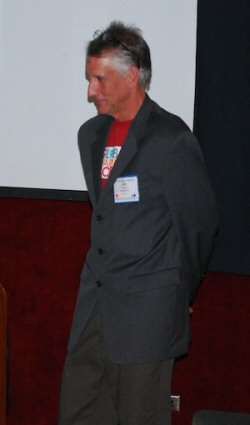 |
|
Jim Poyser |
Is there anything funny about environmental news?
Maybe.
"The objective here is to entice people to pay attention with humor," said Jim Poyser, managing editor of NUVO, an alternative weekly newspaper in Indianapolis.
Humor was the topic of conversation during "The Craft: A Storytelling Playshop" session at the Society of Environmental Journalists conference Friday afternoon, October 21.
Poyser started the online blog ApocaDocs as a satire of the sensationalism that was surrounding the supposed upcoming apocalypse in 2008.
As he later began to believe in the apocalyptic theories, the site developed into a display of the power of humor in journalism. One suggestion Poyser offered was to write fictional stories about real problems on April Fool's Days in order to raise readership and bring attention to important issues.
Tom Konrad, financial analyst and blogger for Alt Energy Stocks, which promotes clean energy investment, wrote an April Fool's Day entry and proved that it is possible to get readers' attention with this approach to writing when he received many comments and emails regarding the post. Having fun with visuals is also a way to use humor to bring awareness, according to another panelist.
"I was an activist for many years and I would stand on street corners handing people leaflets as a way to try to reach people about the problems in our society," said Stephanie McMillan, an editorial cartoonist. "But if you hand someone a leaflet and say 'Capitalism is killing the planet,' they will avoid your eyes."
From this awareness, McMillan built on her ability to draw and started crafting cartoons and comic strips for newspapers in order to be more accessible to the public. In her cartoons, she targets all sides, from the government and those opposing regulation to what she termed environmental "lifestylists."
- Audio file (MP3/00:49:09).
- Session description and speakers.
Concurrent Sessions 2: LATIN AMERICA: Do Tropical Forests Have a Future?
 |
Deforestation Affects Ecosystems, Economies and Societies
By CHIP BRIERRE, University of Miami
Rainforests are being devastated by deforestation across the globe.
Deforestation is slowly affecting not only the ecosystem, but also economies and societies. Professors and scientists who specialize in biology and environmental studies converged at the Society of Environmental Journalists conference in Miami to discuss the growing problem.
Deforestation has had a direct effect on phosphorous levels throughout the globe. Phosphorous is required to grow crops because it aids plant growth. It is a bonding agent in the growing process, one panelist explained.
Christopher Neill, the senior scientist at the Marine Biological Laboratory in Woods Hole, Mass., believes that this is going to be problematic. "As people farm in tropical forests, phosphorous demand will go up," he said. "We're going to have to bolster the agriculture to feed the people."
Wildlife was another point brought up during the discussion. Emilio Bruna, an associate professor at the University of Florida and associate editor of Biotropica, commented on the effects deforestation is having on wildlife.
"Forest fragments are a lower quality," he said. "As a result new species are introduced and larger animals leave because they need a large area to roam. When you have a weak infrastructure, the ecosystem struggles."
People will also feel the effects of deforestation, mainly through the climate, according to the panel.
Bruna believes climate change is "the tipping point" when it comes to the problems of deforestation. Increases in carbon dioxide emissions have made the climatic events more sporadic, he said. David Bray, a professor in the Department of Earth and Environment at Florida International University, claims this loss of vegetation will lead to more powerful and dangerous natural disasters.
"Government budgets are going to come under pressure repairing damage from weather events due to environmental destabilization," he said.
There is hope, though. With the future of the rainforests under question, Bruna and Bray expressed their optimism that the forests will "be there."
"It depends on what we want the forests to be," Bruna explained.
Bray believes the forests will recover. "Biomass also recovers very quickly," he said. However, Neill believes the demands will be too much.
"Our society demands that the rainforests make more food, to produce more energy," he said. "I think the land won't be able to handle that demand."
- Audio file (MP3/01:12:47).
- Session description and speakers.
Concurrent Sessions 2: THE OCEAN: The Day after Tomorrow: Changing Atlantic Ocean Currents and Future Climate
New Research on Ocean's "Conveyor Belt" and Rising Ocean
By ALLISON GORDON, University of Miami
With global warming becoming a rising worldwide concern and the polar ice caps beginning to melt, researchers in South Florida are beginning major long-term studies on the slowing of the ocean's "conveyor belt" and rising ocean tides. Global ocean circulation is mainly thermohaline driven, which means that it is based on the density of the ocean's salt water.
The higher density (salt concentration) of the ocean water causes it to sink in the North Atlantic and the lower density causes it to rise in more southern parts of the ocean. This global circulation is called the ocean's "conveyor belt" and the speed of the conveyor belt has been linked through research to rises in sea level.
Researchers on both the rising sea level in South Florida and the changing speed of the conveyor belt presented some of their research findings on Friday, October 21, at the Society of Environmental Journalists conference in Miami.
Rising sea level in South Florida is a future and current problem. Research done by Nancy Gassman, a Natural Resources administrator and representative for the Natural Resources Planning and Management Division in Broward County and Susan Skemp, executive director for the Southeast National Marine Renewable Energy Center in the College of Engineering and Computer Science at Florida Atlantic University, can predict future effects of the rising sea level in South Florida.
As projected by Gassman's research, sea level will rise 3 to 7 inches by 2030 and 9 to 24 inches by 2060. This spells trouble for certain densely populated areas of South Florida.
Even now, flooding is occurring in certain South Florida neighborhoods. Gassman explained the draining problems that come along with rising sea level. "Our storing systems are holding seawater instead of allowing fresh water to come off the land," said Gassman. Gassman also explained that because South Florida is so flat, the water stuck in the drains has nowhere to go.
The changing speed of the conveyor belt is also a problem, though its specifics are less predictable. Igor Kamenkovich, an associate professor in the Division of Meteorology and Physical Oceanography at the University of Miami, speculated on the possible effects of the eventual slowing of the conveyor belt.
"There are two schools of thought among scientists," explained Kamenkovich, "some scientists will say that it can cause the next Ice Age . . . while some scientists are more cautious. They say, 'Well, yes this conveyor belt does warm Europe, but the effect is not that large.'"
The research being done on the conveyor belt, however, is still in very early stages. According to Christopher Meinen, an oceanographer for the National Oceanic and Atmospheric Administration, this research will take time, resources and money. Although researchers can predict the implications of the relationship between the slowing of the conveyor belt and the rising sea level, they cannot say for sure what the impact will be, or when it will occur. "If we really want to understand this, we're talking a couple of decades and a significant amount of resources," estimated Meinen.
- Audio file (MP3/01:11:17).
- Session description and speakers.
Concurrent Sessions 2: THE NATION: Busting the Bad Guys: Criminal Enforcement of Environmental Laws
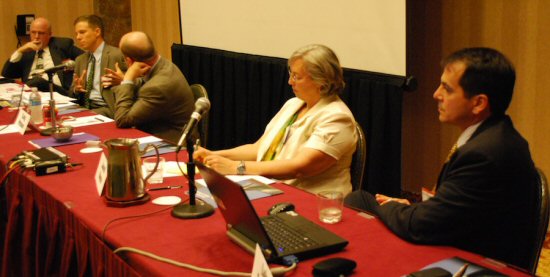 |
Problems and Consequences of Enforcing Environmental Laws
By KATIE GUEST, University of Miami
Over the past century and, especially since the public became aware of the growing extinction of animal species, pollution, and global warming, numerous laws have been put in place to protect the environment.
However, in a discussion session Friday, October 21, at the Society of Environmental Journalists' conference in Miami, panelists spoke about the problems with enforcing these environmental laws and the consequences that need to be pushed on violators.
Concern was focused on illegal harvesting and smuggling of coral, animals and animal parts such as parrot feathers and ivory tusks.
"For example, when we had somebody illegally smuggling bird feathers, not only do we charge the source but also the recipient. As long as we know that they are both knowledgeably involved, we hit all sides of the case," said Henry Barnet, director at the Office of Criminal Enforcement at the U.S. Environmental Protection Agency.
"The protection of human health and environment ultimately is our goal... when we choose to investigate certain cases we make the prosecution as public as possible [so] as to deter others from any similar ideas," he added.
Law enforcement officers involved in the environmental division of the EPA and the U.S. Fish and Wildlife Service most commonly run into the issue of public unawareness. While people, of course, want good air quality, clean water and no invasive species in their backyards, they do not realize that everyday activities can be a partial cause of these problems.
Jerry Phillips, director of the Florida Chapter of Public Employees for Environmental Responsibility, said understanding environmental laws is critical. Public understanding of these critical laws and consistent enforcement are what is most needed, he said.
Each of the panelists offered specific examples of laws broken in Florida. Phillips voiced concerns about the laws regarding harassing of manatees and how the public does not take these laws seriously.
Currently, the only prevention method being used is public awareness of prosecutions, Barnet stated. Until a more effective method is found, law enforcement and wildlife services will stay put, he added.
- Audio file (MP3/01:10:41).
- Session description and speakers.
Concurrent Sessions 2: WILDLIFE AND NATURAL RESOURCES: Florida's Iconic Critters
From Alligators To Goliath Groupers, Florida's Unique Wildlife Faces Habitat Threats, Extinction
By MARI CENTENO, University of Miami
Florida is home to some of the most intriguing animals in America. Some of these special critters were the topic of discussion during a wildlife and natural resources panel discussion held Friday, October 21, during the Society of Environmental Journalist conference in Miami.
These unique creatures are facing dangerous threats of habitat destruction and, ultimately, extinction. Many organizations, communities and scientists are constantly fighting to promote the protection of these habitats and their residents.
One of these creatures is the goliath grouper, a large gentle, charismatic fish that resides in the southeastern parts of the United States. The goliath grouper is critically endangered, mainly from being overfished and the destruction of its habitat.
These fish are very important to the mangroves in Florida, marine biologist Sarah Frias-Torres said.
"Goliath groupers generate an ecosystem of their own and there's a whole food chain depending on them," said Frias-Torres, who works with the Ocean Research and Conservation Association and specifically with the goliath grouper.
Frank Mazzotti, associate professor at the University of Florida, discussed the dangers alligators and crocodiles are facing. Alligators are a federally listed species and represent the importance of freshwater flow into the Everglades, he said. These alligators help maintain the ecosystem by creating alligator holes, which allow other species to co-exist in the Everglades.
However, these alligators are not doing well. According to Mazzotti, alligators in the Everglades grow slower, lay fewer eggs and are also skinnier. On the other hand, crocodiles are an endangered species success story and they have been reclassified from being endangered down to "threatened" status.
"Alligators and crocodiles are very popular with the public; 75 percent of the people want more crocodiles in Florida," said Mazzotti.
Frias-Torres added that a number of studies have concluded that the goliath grouper population increase has been very low in recent years. "Their habitats will never be like they use to be in the '90s, but there are also factors like major fish kills and cold water events that kill 90 percent of the juvenile populations in the mangrove habitats of the goliath grouper," she said.
Perhaps one of the most popular and protected species in Florida is the manatee. A risk-and-threat analysis shows that these manatees may be doing better but still remain in danger of extinction. Watercrafts and cold temperatures are some major factors affecting the manatees.
Pat Rose, executive director of Save the Manatees, said the Crystal River case is an example of the problem the animals face. In the Crystal River, there is a proposal for the water sports zone to be taken away and be replaced with a slow-speed zone all year ’round to protect not only the manatees but the divers looking at the manatees.
"The local public is divided on the issues of manatees. Some say they’re a pest and others are fighting to protect them," said Rose. Improvement for the protection of manatees includes developing more sanctuaries where divers cannot go.
During the question-and-answer period, the panelists were asked whether boaters, fishermen and the power of myths, lies and assumptions had a direct impact on the survival of these species. "If we repeat a lie many times, it becomes true in the collective consciousness," said Frias-Torres. In order to continue the protection of these threatened and endangered species, people have to be shown the truth about what's happening, she added.
- Audio file (MP3/01:08:48).
- Session description and speakers.
Concurrent Sessions 2: ENERGY AND CLIMATE CHANGE: Climate Change and Indigenous Peoples on the Frontlines
Climate Change Threatens Indigenous Cultures
By CHRIS WITTYNGHAM, University of Miami
Native American Indians are losing that which defines them, and some of this is due to climate change, says Margaret Hiza Redsteer, research scientist at the Flagstaff Science Center in Arizona.
Redsteer and a panel of experts discussed the impact of climate issues upon native cultures Friday afternoon, October 21, at the Society of Environmental Journalists' conference in Miami. Redsteer said she wonders where the future of the native people is heading because of climate change.
"How are you going to define what it means to be a native person?" Redsteer asked the gathered audience. "All the iconic things that we use to identify ourselves and our traditions are disappearing."
Author Scott Wallace, who wrote a book about the last uncontacted tribes of the Amazon rainforest, offered staggering statistics about technology, change and the environment. With the introduction of the chainsaw and the bulldozer, he noted, there has been more deforestation in the past 50 years than there had been in the previous 450 years.
"Climate change may end up undoing all of this because we know in the Western Amazon, the forests are drying out, creating droughts and wildfires," said Wallace.
Also on the panel was Neet’sai Gwich’in, known as Sarah James to her American contemporaries, who discussed the impact of climate change on the tribes of Arctic Alaska. She pleaded for people to tell her story. She said that even if we listened to her speak, we wouldn’t grasp everything she was saying.
"There aren't enough indigenous people here to understand," said James. "None of our land needs to be saved, it just needs to be preserved."
James told stories of how several nearby villages had to relocate after land eroded away due to the effects of climate change. She also said that she doesn't know what the weather was going to be like on a given day. A large portion of the session was spent answering audience questions, including questions about protection agencies.
"Some areas are very well protected and other [places] the protection is a matter of on paper and not particularly real," said Wallace. "The Amazon is so huge, and the resources they put into protecting it are so scarce, you have areas of Brazil where hundreds of thousands of square miles [protected] with just a couple of ... guards.
"More important than anything to Redsteer and James, who represent segments of the indigenous population, is simply getting their story out to people and trying to allow people to be aware of their cause. "Politically marginalized people can be a threat to people in nearby communities," said Redsteer. "And it ends up becoming a political issue."
- Audio file (MP3/01:08:11).
- Session description and speakers.
Concurrent Sessions 2: POLLUTION AND SOLUTIONS: Diseases and Chemicals: Are Environmental Exposures Fueling Our Worst Epidemics?
Chemicals Have Effects on Epidemic Human Health
By ALYSSA KARAS, University of Miami
We know some of the obvious chemical "bad guys," such as arsenic and mercury, when it comes to environmental health. But recently, these and other chemicals have been identified as also having effects on epidemic human health conditions such as obesity and diabetes, along with other health issues such as cardiovascular and respiratory disease.
Panelists Bruce Blumberg, Kristina Thayer and moderator Marla Cone shared their research and expertise about the role of chemicals in triggering such diseases at the Society of Environmental Journalists' conference in Miami.
Carcinogens are old news, according to Cone, editor of Environmental Health News. The newly discovered attackers are chemicals that disrupt hormone receptors in the endocrine system.
For example, tributyltin (TBT) is a compound that has an effect on the receptors that regulate fat cells. Chemicals such as these have been dubbed "obesogens."
"The causes of obesity that we hear are overly simplistic," Blumberg said.
Blumberg, a professor at the School of Biological Sciences at the University of California, Irvine, cited numerous studies that show diet and lack of exercise are not solely to blame, though they do have an effect. Animals are exposed in utero, she said, and so are born predisposed to gaining weight.
About 70 studies show maternal smoking as another prenatal risk factor for childhood and adolescent obesity, according to Thayer, the Health Science administrator at the National Toxicology Program Division at the National Institute of Environmental Health Sciences. "This told us that there was a real biological plausibility that an environmental factor could be a risk factor for childhood obesity," Thayer said.
Recently, a relationship has been found between higher levels of diabetes in countries where there are high levels of arsenic in drinking waters, such as Taiwan and Bangladesh. Persistent nonorganic pollutants, such as PCBs and DDT, have also shown fairly consistent associations, though there aren't many studies to back this up yet. Where can you be exposed to these malevolent chemicals? "The better question is 'where aren't you exposed?'" said Cone. It was first widely thought that oral consumption was the main culprit, but now research has pointed fingers to hospital appliances, dust and household objects such as purses and wallpaper. According to Blumberg, you can't be too careful.
The session was packed to capacity in both attendance and information, but all of the panelists admitted that there is much more research to be done. "The field of chemicals and obesity is very young," Blumberg said.
- Audio file (MP3/01:08:34).
- "Obesogens: An Environmental Link to Obesity," Environmental Health Perspectives, February 1, 2012, by Wendee Holtcamp.
- Session description and speakers.
Concurrent Sessions 2: THE GLOBE: China and U.S. Energy Policies: Green or Mean on the Environment?
 |
Energy Policies of China and the U.S. Impact Local and International Environment
By ALEJANDRA ACUNA, University of Miami
The energy policies of China and the U.S. and their effects on the environment both locally and internationally are substantial, a group of experts said at the Society of Environmental Journalists conference in Miami on Friday afternoon, October 21.
The discussion was moderated by Keith Schneider, senior editor of Circle of Blue, a network of leading journalists reporting the global water crisis.
The broad spectrum of views on the topic reflects the polycentricism of the relationship of China and the U.S. in terms of environmental policy. This is an issue that relates from water to agriculture, to diplomatic leadership, to ethical values and back to the global necessity for alternative fuel.
Joshua Freed, vice president of the Clean Energy Program, said China ranks first in the world in clean energy investments as well as accounting for 50 percent of photovoltaic solar panels and wind turbine production.
Dan Weiss, senior fellow and energy and climate expert for the Center for American Progress, said another source of energy available in China is shale gas, which emits 50 percent less pollution than coal, but which is just beginning to be explored.
"The U.S. has over 800 million cubic feet of shale gas and can last us over 100 years," said Weiss. "China has even more and they have not even begun exploiting it." The problem with having China use its shale gas reserves, he said, is that the production of useable gas could result in more carbon dioxide emissions than coal; without standards to enforce clean production in a weak government, the results might not be favorable.
Mainly, China produces 3.5 million tons of coal, which is an environmental problem, especially with carbon dioxide emissions. "China's fueling growth is based on coal," said Schneider. "It's likely not going to change."
Jonathan Lewis, staff attorney and climate specialist of Clean Air Task Force, discussed using carbon capture and storage, a developing technology that involves collecting carbon dioxide in the air and storing it underground.
Christine Boyle, research fellow of Environmental Finance Center at the University of North Carolina, offered the agricultural perspective and highlighted the pressure placed on farming because of the increased demand for energy. "Water scarcity in northern China has spread all over the nation," said Boyle, adding that water for agriculture is competing with water for energy production.
- Audio file (MP3/01:19:12).
- Session description and speakers.
Special Newsmakers Forum: Sylvia Earle
- Audio file (MP3/00:34:15).
- "Fishing, Mining Threaten the Oceans," Watchdog Earth blog, Louisville Courier-Journal, October 22, 2011, by James Bruggers.
- Session description, speakers and Powerpoint presentation.
Beat Dinner 1: Extreme Weather Events and Climate Change: A Conversation with NOAA Director Jane Lubchenco and National Hurricane Center Director Bill Read
- "Weather satellite budget cuts a 'disaster in the making' — Obama official," The Guardian, October 24, 2011, by Suzanne Goldenberg.
- "Climate Change Impacts Industry Practices," Turf Magazine, December 2011, by Carol Brzozowski.
- Session description and speakers.
Beat Dinner 2: Dinner with the New US Fish and Wildlife Service Director Dan Ashe
- "Ashe: Exotics Are the States' Job," State Wildlife Research News, October 24, 2011, by Madeline Bodin, editor.
- "US Says It Plans To De-List Grey Wolf," Wisconsin Public Radio, October 24, 2011, by Chuck Quirmbach.
- "Development company controls key to Florida panther survival," St. Petersburg Times, November 5, 2011, by Craig Pittman.
- Session description and speakers.
Saturday, October 22
Dig, Investigate, Get Results! — An NAHJ Workshop
- Audio file (MP3/01:25:22 only, due to technical difficulties).
- Session description and speakers.
Breakfast Breakout 1: Someone to Watch Over Us: Mapping Earth from Space
- Audio file (MP3/01:02:18).
- "Lost in Space," iWatch News, October 24, 2011, by Douglas Fischer.
- Session description and speakers.
Breakfast Breakout 2: Shark Attack: "Humankind at Its Worst"
- Audio file (MP3/00:44:26).
- Session description and speakers.
Concurrent Sessions 3: LATIN AMERICA: Cuba Begins Oil Drilling 40 Miles Off U.S. Shores
|
© Photo by Luana Goncalves. |
The Need for Critical Dialogue Between U.S. and Cuba with the Emergence of its First Drilling Project
By BIANCA CONDE, University of Miami
In six weeks, Cuba is planning implementation of an exploratory drilling project about 50 miles up-current from South Florida.
Due to the potential threat of an oil spill, both Cuba and the U.S., as well as other countries in the Gulf of Mexico whose coastline and marine habitats can be affected by a spill, need to be in constant litigation and dialogue, Daniel Whittle, Cuba program director of the Environmental Defense Fund, told a group of journalists at the Society of Environmental Journalists' conference in Miami Saturday morning.
There is an urgent need to come up with a plan to manage a high-risk event if it were to occur in order to avoid an incident like the 2010 BP oil spill, he added. "This event should generate game changes in [the] U.S. and Cuba relationship since it is in both countries' best interest to foster a better relationship in order to protect the marine and coastal environments," Whittle explained.
The topic discussed thus raises both economic and environmental issues, stated Jorge Piñón, oil and gas expert and visiting research fellow at Florida International University.
On one hand, the execution of a successful rig will be economically beneficial to Cuba. Piñón said the successful achievement of this exploratory drilling project will provide about the exact amount of barrels needed for Cuba to sustain itself.
Due to its value to the Cuban economy, top-of-the-line equipment is being used to construct the rig. Further, strict regulations are being implemented to avoid a high-risk incident.
However, said John Proni, executive director of the Applied Research Center at Florida International University, construction of the exploratory rig raises air, water and habitat impacts.
Apart from the threats that can be raised as a result of an oil spill, the drilling project's implementation can release drilling fuels that produce local impacts on Cuban reefs as well as distant impacts when these fuels reach the Gulf Stream and travel towards U.S. coral reef habitats in the Florida Keys National Marine Sanctuary.
The drilling project's potential threats to both nations, regardless of its potential profit, creates the perfect conditions to encourage critical dialogue between the U.S. and Cuba. The circumstances for an environmental bridge and diplomacy are reflected in the Cuba drilling case. There has been precedent for constructive engagement and this could possibly be another example, said David Guggenheim, senior fellow at the Ocean Foundation.
- Audio file (MP3/01:15:14).
- Session description and speakers.
Concurrent Sessions 3: THE OCEAN: An Alarming Update: Coral Reefs and Ocean Acidification
|
© Photo by Luana Goncalves. |
Fragile Reef Structures at Risk from Global Warming, Ocean Acidification
By ANABELL BERNOT, University of Miami
Coral reefs, known as the ocean's "tropical rain forests" for their diversity and productivity, are in danger of becoming extinct by the end of this century due to global warming and ocean acidification. "The Ocean — An Alarming Update: Coral Reefs and Ocean Acidification," a session at the Society of Environmental Journalists' conference on Saturday, October 22, covered some of the most pressing dangers coral reefs are facing.
"Corals are one of the most fragile and important organisms on earth," said Andrew Baker, associate professor at the Rosenstiel School of Marine and Atmospheric Sciences at the University of Miami, who studies the effects of ocean acidification.
Corals are simple-structured animals related to anemones and jellyfish that build skeletons that keep them anchored to the sea floor. "The coral are the critical ecosystem engineers; they built the structure in which other organisms depend on," said Baker. "You can not have a reef ecosystem without any corals."
Corals are important because they leave skeletons made from calcium and carbonate on the ocean floor. However, due to rising temperatures from global warming and the rising levels of carbon dioxide, corals are not able to calcify and build their skeletons.
Carbon dioxide can threaten these organisms by making the ocean more acidic, leading to warmer oceans which make corals bleach. "What really worries us as biologists is that carbon dioxide will threaten the life of corals," said Baker.
"As the water is more acidic, the corals are more susceptible to bleaching at the same temperature," said Mark Eakin, coordinator of Coral Reef Watch. Scientists refer to the combination of global warming and ocean acidification expected by the year 2100 as the "no analog earth" because these conditions have not occurred for 50 million years.
"So far to this point changes have been gradual compared to what they are going to be at the end of the century," said Eakin. "In order to prevent the loss of reef structure we have to reduce the amount of carbon dioxide immediately."
- Audio file (MP3/01:14:41).
- "The Ocean Gets Something Like Osteoporosis," Watchdog Earth blog, Louisville Courier-Journal, October 22, 2011, by James Bruggers.
- Session description and speakers.
Concurrent Sessions 3: THE NATION: Clean Water Act: Who's in Charge?
|
© Photo by Luana Goncalves. |
Panel Debates Implementation of Clean Water Act in Florida
By ALYSHA KHAN, University of Miami
The objectives of the Clean Water Act of 1972 are simple — to regulate the level of pollutants in the water and to ensure that it is safe for human use and consumption.
Its implementation, however, has become a thorny issue.
A group of experts at the Society of Environmental Journalists' conference in Miami discussed how the implementation of Clean Water Act by the Environmental Protection Agency in Florida led to a lawsuit by the state against the George W. Bush administration.
The main pollutant in Florida's waters is nutrients that flow of farmlands and cause large algal blooms.
"If your dog drinks out of it, it'll kill it," said David Guest, managing attorney in the Florida office of Earthjustice.
When Florida failed to implement a program to corral the issue in a timely manner, the EPA stepped in.
"We were encouraged by some of the progress we were seeing,” said Robert Sussman, senior policy counsel to the administrator of EPA. "But if progress is not sufficient, we have a responsibility to act and we will step in."
The current lawsuit accuses the agency of setting harsh standards and of trampling over Florida's right to police within its own borders. Several groups representing farmers have joined the suit alongside Florida. "It's difficult to have a near-pristine standard and produce food," said Don Parrish, senior director of Regulatory Relations at the American Farm Bureau Federation. "You can only do so much. [The regulations] are not only going to drive the cost of production up but also drop land out of production."
Drew Bartlett, director of the Division of Environmental Assessment and Restoration for the Florida Department of Environmental Protection, admits that some of Florida's water bodies are "impaired."
However, he feels that the EPA's actions did not "avoid unnecessary costs" and did not take into consideration local issues. "It depends on how the numbers are applied," he said. Parrish accused the EPA of wielding a "hammer in velvet gloves," but Sussman held firm on the legitimacy of the agency's actions. "We are not insensitive to economics considerations, and we are certainly not insensitive to political ones," he said. "Having said that, the goal of the act is clear."
- Audio file (MP3/01:16:08).
- Session description and speakers.
Concurrent Sessions 3: WILDLIFE AND NATURAL RESOURCES: The World's Most Aggressive Restoration Project: The Everglades
|
© Photo by Luana Goncalves. |
Status Quo Overcome in Moving Everglades Restoration Forward
By INGRID CASTILLO, University of Miami
Money and politics have been the central problems of many restoration projects in the past, but the speakers at the Everglades restoration project panel at the Society of Environmental Journalists' conference Saturday morning don't plan on standing still for the status quo.
"We are in a pivotal point in time in the Everglades restoration.... What we do when resources are very scarce matters a lot," said Shannon Estenoz, director of the Everglades Restoration Initiatives for the U.S. Department of the Interior.
Michael Putney, political reporter for WPLG-TV in Miami, moderated the panel that consisted of Estenoz, Kirk Fordham, chief executive officer for the Everglades Foundation, and Dexter Lehtinen, former U.S. attorney.
Estenoz stated that these restoration projects find themselves in a new decision-making process where they have to allocate their resources differently than in past years. She said that, for 10 years, restoration of the Everglades had been focused on the edges of that ecosystem. She said it's time that attention be turned to the center of the region and the river of grass itself.
Lehtinen kept the focus on money and politics. "It's not money or creative law making... it's implementation," said Lehtinen about how very often bureaucracy can create stagnation in restoration projects. "We are not able to follow a comprehensive plan for bureaucratic reasons."
For some, restoration projects are considered more of a liberal social initiative. Lehtinen proposes moving away from the social aspect of restoration and emphasizing the business side. He believes that to bring in more conservative viewers to care about the Everglades restoration, it's very important for conservatives to realize that if some of these regulations or restoration projects linger it would cost more in the long run. Failure to implement fiscally conservative policies in these restoration projects now is letting problem areas worsen and will ultimately require more financial resources, he said.
Fordham echoed some statements by Estenoz and Lehtinen and said that although in the past the Everglades Restoration Project has tried very ambitious projects such as attempting to buy land owned by U.S. Sugar Co., the group had to come to terms with available resources and settled for buying only certain critical tracts. "We don’t need all of the land U.S. Sugar owns, we just need portions of it," said Fordham.
- Audio file (MP3/01:08:18).
- Session description and speakers.
Concurrent Sessions 3: ENERGY AND CLIMATE CHANGE: Critters and Climate Change: Winners and Losers
|
Far left: Jake Weltzin. © Photo by Luana Goncalves. |
Winners and Losers When Climate Change Impacts Wildlife
By SAIRA R. SUMBAL, University of Miami
Climate change impact on animals has created two sides: the winners and the losers.
A panel at the Society of Environmental Journalists conference Saturday said climate change affects species differently, and the result can be positive for some and negative for others.
"Comparing the winners and losers is like comparing apples and oranges," said Kassie Siegel, director of the Climate Law Institute and senior counsel for the Center for Biological Diversity.
Siegel said the warming of the globe will continue unless there is a reduction of emissions. She added that a distinction between species that win and lose does more harm than good. "Most fundamentally, some species doing better in some fashion can't simply balance out the extinction risk," said Siegel.
Jake Weltzin, executive director for the USA National Phenology Network, U.S. Geological Survey, spoke about what should be done with the species that don't get a winning ticket in climate change. Weltzin also discussed how phenology, the cycles and time frames in which plants and animals function and develop, is another major aspect in the discussion of climate change.
"There are lots of losers and so we have to prioritize on how to deal with that," said Weltzin.
Paul Tritaik, an expert in sea turtle habitat, said climate change can have a potential negative effect on sea turtles. "It is hard to assess what impacts there are going to be, but the impacts we see appear to be negative," he said.
Sea turtles are made up of five species in Southeast Florida. Changes to the shoreline have an impact on sea turtle nesting habits. In addition, the rise of sea levels poses an additional threat.
The panel also spoke about the negative effects of climate change on specific species. One of those species includes polar bears, a group whose numbers were at their lowest in 2011.
The group also reflected on solutions to climate change, including the use of legislation. "That's one thing I personally focus on — we have laws, let's use them," said Siegel.
Concurrent Sessions 3: POLLUTION AND SOLUTIONS: Kids These Days... Looking Out for Their Own Future
|
L-R: Larissa Weinstein, Maddie Cowen, Sean Russell, Jordan Howard and Erich Christian. |
"Teaching Kids To Take Charge" for Green Transformation
By ELY SUSSMAN, University of Miami
Young environmental activists discussed the initiatives they started at their schools and in their communities and actions their generation can take to improve the environment, during a Saturday panel session at the Society of Environmental Journalists' conference in Miami.
Larissa Weinstein and Maddi Cowen saved their school $53,000 through an energy audit as eighth graders at Carver Middle School in Miami. They credit their biology teacher for peaking their interest in the environment. Their work was covered in "Dream in Green," a documentary produced by moderator and environmental children's book author Lynne Cherry. "Everybody wanted to help us succeed," Cowen said. Weinstein and Cowen urged students to participate because energy savings were used to address school needs, such as purchasing textbooks. Cowen called it "a win-win situation for everyone."
Sean Russell has worked to save dolphins in Sarasota from the threats they face from used fishing equipment. Specifically, monofilament fishing line poses a danger. To prevent this, Russell launched his "Stow It-Don't Throw It" program, where he converts tennis ball cans into recyclable containers for the used lines. He explained that, "young people are the most receptive audience... a vehicle to take the message out into the larger community."
Russell recommended a website, Earth Eco, for its great resources that help students launch their own conservation programs.
Student Jordan Howard led her charter high school in Los Angeles through a "green transformation" during her sophomore year. Howard planted dozens of trees at her school and in the community, and set up bins for plastic recycling and compost.
Howard admits that she was initially resistant to the green movement simply because she had no knowledge of it. Now, her goal is to raise awareness.
Howard edited Green My Parents, a book geared towards children. It's about "teaching kids how to take charge," Howard said, and encourage their families to make changes. She said that the ideas provide sustainability and savings. "Plastics Are Forever," an international summit she held in Los Angeles, took place in March with representatives from 14 countries.
Erich Christian converted vegetable oil into biodiesel fuel at Oak Hill High School in Gainesville. Fla. He ran the operation out of a shed at the school beginning in his junior year. Christian was appointed to the Alachua County Commission's Energy Conservation Strategies Committee soon after. Christian saw biodiesel work its way into the curriculum of his environmental science class. He believes it's imperative that the same happens in other schools across the country. Students will participate if we make it relevant, Christian said.
- Audio file (MP3/01:11:58).
- Session description and speakers.
Concurrent Sessions 3: THE EXTRAS: Media Critics Dissect Science and Environmental Journalism
|
© Photo by Luana Goncalves. |
"1,000-Foot View" of Journalism Finds Good, Bad, and Funny
By DANIELA GONCALVES, University of Miami
Laughs, stories, and reminiscing. This is not really what you would think would happen on a panel about media critics at the Society of Environmental Journalists' conference in Miami, but it did.
The panel began with moderator Curtis Brainard, science editor at The Observatory of Columbia Journalism Review, who pointed out that the panel's main objective was to give its "1,000-foot view on some of the goods and the bads in the world of journalists today."
The Columbia journalism school graduate pointed out that blogs and Internet sites with similar purposes have become more and more a source of media criticism. "One of the central occupations of blogs is analyzing media," Brainard said. "The web tapped in to this unfulfilled desire for review."
Panelist Bud Ward, co-founder of SEJ and currently the editor of The Yale Forum on Climate Change & the Media, said the interesting angle of the Internet is that on these kinds of websites, the media can be very "broadly defined." He mentioned analyzing non-conventional critiques such as theatre, the arts and television programs.
"Journalism has changed a lot," said Ward while mentioning websites of media critique such as The Huffington Post, The Conversation.edu.au and Skeptical Science.
Ward brought up an issue he has with publishers' regulations as to what gets published and the process the articles undergo before they are released for public browsing.
"I don't know if that's truly blind journalism,' Ward said.
He read a quote aloud from the SEJ ListSERV about a journalist who attended a protest in Washington and was offering his first-hand account "off-line" to any interested colleagues. Ward found it strange, to say the least, that a journalist had to employ another journalist to comment on the topic freely "off-line."
In the world of media criticism throughout the World Wide Web, although common "Tweeters" may criticize media, two panelists present had professional authority on the topic of blog-style media criticism.
Paul Raeburn, a blogger for the Knight Science Journalism Tracker, and Pere Estupinyà, the KSJ Spanish language blogger, provided some insight on the topic.
Raeburn said there were downsides to being a media critic. "When I'm criticizing media, I'm criticizing all of us," Raeburn said as he related a comical story of his own shortfalls in critiquing a New York Times front-page article.
"If you make a mistake, people will not be shy about pointing out your mistake," he said. Raeburn brought levity to the room assuring his colleagues this was "the only mistake [he] ever made in 20 years."
Estupinyà brought a different flavor to the panel. He related the positives of media criticism, especially in Latin American.
"What I really like to do is to encourage people to make a network to connect different journalists in the Latin American world, especially about the environment," he said. With so many natural resources, there are many stories for environmental journalists in Latin America but these, though important, go unreported, Estupinyà said. He described his job as finding "these stories that are untold."
"The Amazon is more interesting than the universe, but it doesn't have the communications office of NASA," he said. The panel ended with final comments, questions from the experts in the room and even a few laughs about an audience member’s Twitter sessions going live during the panel.
- Audio file (MP3/01:13:38).
- Session description and speakers.
News Conference Podium: U.S. Forest Service
 |
|
U.S. Forest Service Chief Tom Tidwell. |
- "Forest Service Chief Says Colorado Roadless Rule Will Enhance Wild Land Protections on National Forests," Fort Collins Coloradoan, October 22, 2011, by Bobby Magill.
- "US Forest Service Chief on Roadless Ruling," Wisconsin Public Radio, October 24, 2011, by Chuck Quirmbach.
- Session description and speakers.
Concurrent Sessions 4: THE CRAFT: DocumentCloud, Google Ocean and Google Earth: Data Tools You Need Now (And They're Free!)
|
L-R: Charlotte Vick, Amanda Hickman (standing), Dan Fagin. |
Panel Teaches Journalists New Online Tools
By ALYSHA KHAN, University of Miami
The latest digital tools for environmental journalists are DocumentCloud and Google Ocean, and participants at the Society of Environmental Journalists' conference in Miami got a quick course on using these tools during a Saturday morning panel session.
DocumentCloud is an online catalog of user-uploaded documents that can be annotated, organized, shared and published. It is free to use.
"Our biggest competitor is highlighters and Post-Its, but you can't search those," said Amanda Hickman, program director of the website. The site is mostly geared toward news organizations that have formal newsrooms, but is slowly becoming more freelancer-friendly.
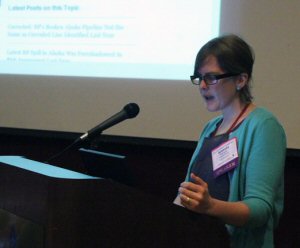 |
|
Amanda Hickman. |
"It's increasing its use as a research tool as time goes on," Hickman said. Once a single document or a set of documents are uploaded, the user can interact with them in multiple ways. They can organize a group of documents by date, share them with outside experts and link to portions of the document in the online version of a news article. "You're inviting your readers to fact check," Hickman said. "You're letting them in on the story. It makes it more engaging." She emphasized that the documents uploaded should mostly be source documents in order to prevent any violation of copyright laws.
The second tool introduced during the session was Google Ocean, an extension of Google Earth. Users can access this portion of Google Earth by zooming in until they see the water's surface and then pressing "shift" and the "down arrow" keys together.
As users move around underwater, they will encounter white dots that represent stories that have been uploaded by the Sylvia Earle Alliance. On the alliance's website, users can also access the stories by searching for specific topics.
"It's growing," said Charlotte Vick, Google content manager for the Sylvia Earle Alliance. "This year we are moving into Spanish, French and Portuguese."
Vick also took session participants through a general tour of Google Earth.
"There are tutorials for virtually anything and everything you want to do," Vick said. "If I can do it at my age, you can definitely do it."
She recommended that users visit Google's LatLong blog if they had any further questions.
Dan Fagin, moderator of the session and an associate professor at New York University, reminded the audience to be careful about using the material they found, but to also actively use their tools. "It's somewhat of the Wild West, but the sensible rules of the road should apply," Fagin said.
"Don't be afraid to plunge in and find new ways to tell stories.
Concurrent Sessions 4: LATIN AMERICA: Caribbean Environment: From Cuba's "Paradise" to Haiti's Nightmare
|
L-R: Gregor Hodgson, Marianne Kleiberg, David Guggenheim, Nadine Patrice, Susan Soltero. |
In Caribbean: Forests and Fish Are Dwindling, Education and Enforcement Needed
By JORDAN N. EMANUEL, University of Miami
Luscious trees, vibrant plants and sunshine sound like a picture-perfect vacation.
But what if the trees were bare and lifeless or the vibrant plants dull and droopy? That would not be so appealing. The growing problem of deforestation and lack of plant life is causing concern in the Caribbean, especially in Haiti.
According to Nadine Patrice, executive director of Operation Green Leaves Inc., in 1924 Haiti was 60 percent covered with forests. That percentage has dwindled to 1.5 percent. The majority of this decline can be attributed to deforestation, pollution, overpopulation and lack of conservation resources. "The issue is not protection of these areas, it's about enforcement," said Patrice. "Enforcing protection of the forests [is] complicated by poverty. Thirty-five of the forests in Haiti are protected, and only three currently have enforced protection."
With so many people living in the country, Haiti has suffered a tremendous loss of fish to feed its nation. Due to the decline in fish reproduction, the sizes of the fish that are still catchable are declining as well.
David Guggenheim, the "Ocean Doctor," a senior fellow at The Ocean Foundation and director of the Cuba Marine Research & Conservation Program, displayed a video of Haiti's people fishing for their week's dinners. According to Guggenheim, the biggest fish those men or anyone else had caught during the past few years were no larger than six inches.
With such pressing issues, there is a concern that things will only grow more devastating, but Patrice believes there is hope.
"The issue is working with the people and changing their ways and bad habits into ways to benefit the environment and later benefit them," she said. "So I stress the importance of education and awareness. I am sure with our new pro-environment government members, things will only get better.”
- Audio file (MP3/01:12:56).
- Session description and speakers.
Concurrent Sessions 4: THE OCEAN: Deep-sea Exploration: Drugs, Damages, and Other Discoveries
Discovering Deep-Sea Treasures
By ANABELL BERNOT, University of Miami
The ocean covers 75 percent of the earth’s surface, yet scientists have only investigated about 5 percent of it.
In the "Deep Sea Exploration" session at the Society of Environmental Journalists' conference on Saturday morning, October 22, in Miami, speakers discussed the importance of human-occupied vehicles to explore the ocean and the possibility of producing marine drugs through the use of these vehicles.
"If you want to understand the earth, you have to understand the ocean," said Mark Schrope, freelance journalist specializing in mid-ocean ridges. "We have more maps and have made more discoveries about space than the ocean; it still remains mysterious."
In order to further explore the ocean, scientists are using camera systems like the "moored eye-in-the-sea."
"Using these cameras while underwater has helped us study the nature of species like the six-gilled shark and a new organism that resembles a squid that is so unique that it can't even be categorized into a species," said Edith Widder, president of the Ocean Research and Conservation Association.
To prepare for an ocean adventure, scientists do not just jump into the sea. "We don't just tend to dive, we use maps first. Ships, cameras and sonar systems are all used to plan a dive into a small area," said Schrope.
|
Panelist Michael Perfit. |
One of the human-occupied vehicles that has aided in deep ocean exploration is ALVIN, the most successful and efficient human occupied vehicle in deep-sea exploration. ALVIN has recently been upgraded. Now the vehicle has more room making it more comfortable, has five view ports, better control and can navigate to depths of 6,500 meters or about four miles.
"In my perspective, human-occupied vehicles are the only way to explore the ocean if you're interested in exploring the biology," said Widder.
Another aspect of deep-sea exploration is taking advantage of submersibles to make marine drugs. Commonly used drugs that have rooted from ocean exploration include aspirin and penicillin. More than 62 percent of small-molecule agents approved for use as drugs can be traced back to natural products produced by microbes, plants and invertebrates.
"Within our program we are working primarily on things to cure cancer, but we are also looking at anti-malaria and neurodosis cures," said Amy Wright, director of Marine Drug Discovery.
Concurrent Sessions 4: THE NATION: Does the Environment Impact Ethnic Groups Disproportionately? Does Anyone Care?
|
L-R: Marcelo Bonta, Paola Elorza, Steve Curwood, Richard Gragg, Ayana Meade. |
Race and Ethnicity Help Shape Environment
By SAIRA R. SUMBAL, University of Miami
Many factors play a part in shaping the environment. Two of these are race and ethnicity.
At a Society of Environmental Journalists' conference session, "Does the Environment Impact Ethnic Groups? Does Anyone Care?" a group of panelists discussed how minority groups shape the environmental movement.
One of the issues the panelists discussed was minority participation in environmental groups and ways to increase involvement.
Panelist Marcelo Bonta, founder and executive director of the Center for Diversity & the Environment, said the lack of participation is due to numerous reasons, the culture of the environmental movement being one of them. "The root issue is the homogenous culture in the environmental movement," he said. "It's not necessarily the makeup, but the exclusive culture of environment groups."
Other panelists discussed how they do not believe there is a lack of minority participation in today's environmental movement. "From a historical perspective, we have always been involved with the environment," said Richard Gragg, associate professor and chair for the Center for Environmental Equity and Justice at Florida A&M University. Gragg stressed that, though there is minority participation in environmental groups, there is still a need to increase participation through community networking. "You have to engage people with where they are," said Gragg.
The panel also shed light on how leadership amongst minorities in the environmental movement comes into play. Steve Curwood, host and executive producer of "Living on Earth" for Public Radio International, called upon examples such as the Environmental Protection Agency's Lisa Jackson as minority leaders who are a part of the environmental movement. But he went on to explain that these leaders do not always get the attention they deserve. "There are minority leaders, but I'm not sure they are being acknowledged by the press," he said.
The panel went on further to talk about how to engage people of color in the environmental sector. Some panelists highlighted the need to go out into communities, while others discussed the responsibility the media has in engaging people of color. "We as media have a huge responsibility to educate people, said Paola Elorza, a meteorologist for Univision in Miami. "It is our mission to work with government agencies and organizations to help spread our message."
Concurrent Sessions 4: WILDLIFE AND NATURAL RESOURCES: Invasive Species: Pets or Pests — Can We Keep Our Critters Contained?
Significant Increase in Pet Trade Imports
By ALEXANDRA HURTADO, University of Miami
With a reticulated Burmese python skin draping the table, a panel of experts met to discuss the issue of invasive species in South Florida and across the country. Susan Jewell, a wildlife biologist and author of Exploring Wild South Florida, served as the moderator and introduced the four panelists at the Saturday morning, October 22, session of the Society of Environmental Journalists' conference in Miami.
From 2000 to 2006, 1.48 billion live animals were imported into the United States, and 90 percent of those animals were for pet trade. In the past two years, there were two billion animals imported, reflecting a significant increase in the pet trade.
Lad Akins, founding executive director of Special Projects for Reef Environmental Education Foundation, said South Florida is a hot spot for non-native species, including fish.
Akins brought up one example of an invasive species in the Atlantic Ocean, the lionfish, which is reproducing at a higher rate than the native range. "They established themselves across a very broad area in a relative small time period," he said. These fish are eating a wide variety of prey that is native to reefs. There has been a 95 percent decline of native reef fish as a result of the lionfish invasion.
"The impacts are the key issue," Akins said. "These impacts can be quite dramatic and severe."
One factor that is facilitating this growing species is the lack of predators.
"They have no predators except us, and it is going to come down to us to minimize this invasion," Akins said.
Peters Jenkins, executive director of Center for Invasive Species, followed Akins. Jenkins focused primarily on the need for regulation.
In order to prevent disease and ecological disaster we need to stop importing exotic animals he explained; simply educating the public would not suffice.
"The industry cannot regulate themselves," Jenkins said. "About 3,000 non-native species have been imported."
He discussed another hot issue in Florida, the Burmese python.
"For five years we have tried to regulate the Burmese python and have spent $1 million dollars of taxpayer money to try to regulate these snakes," Jenkins explained. "It's not about science anymore, this crazy notion that it is overregulating this industry... anything that looks like regulation is going to be quashed."
Marshall Meyers, senior advisor for the Pet Industry joint Advisory, also touched on regulation.
The "one-size-fits-all" approach doesn't provide flexibility or take into account the different regions, Marshall said.
Lori Williams, executive director of the National Invasive Species Council, followed Marshall. The council was set up at the request of scientists and people around the country saying the invasive species problem was not being dealt with adequately. The council, which has 13 agencies, works together to bring top-level attention to problems involving non-native species. "There was a lack of sharing between the different programs before," Williams said. "There are a lot of common lessons that can be learned."
Williams praised the press for raising awareness of invasive species but stressed that the only way to really deal with this issue is prevention and rapid response to these invasive species. People need to realize the danger and damage they inflict by releasing exotic pets into the wild, she said.
"It's real hard to convince people to take these steps; some are just changing behaviors and people understanding that what they are dong is adding to this invasion," Williams said. "In real estate it's location, location, location; with invasive species it is pathway, pathway, pathway."
In short, non-native visitors are not welcomed, or so it should be in the wild, yet today there are growing numbers of invasive species as a result of these exotic pet trades.
Concurrent Sessions 4: ENERGY AND CLIMATE CHANGE: Energy Subsidies: Where's the Money Going?
|
© Photo by Luana Goncalves. |
Hot Debate For and Against Energy Subsidies
By MATT HOUSTON, University of Miami
Should the government invest in, and give out, subsidies for renewable energy? A panel of experts met at the Society of Environmental Journalists' conference to discuss this issue as well as others regarding energy subsidies.
Within the issue, there is heated debate about which forms of energy were most important, which forms of energy deserved the subsidies and which did not.
Kathleen Sgamma, director of Government and Public Affairs at Western Energy Alliance, and Peter Kelley, vice president at American Wind Energy Association, went head to head on numerous issues.
Sgamma, who focused on the gas and oil industry, believed that these fossil fuels were by far the most important energy for the United States in terms of production, while Kelley argued that wind energy could be of immense importance down the road in producing cheap, clean energy, as well as providing thousands of jobs for Americans.
Kelley stated that wind energy is slightly more reliable than other forms of energy because it is predictable. Because of this, he said, the government should seriously consider wind energy as a major source for producing American energy. Sgamma did not believe that wind energy was more reliable than other sources of energy, specifically oil and gas energy.
Paul Bledsoe, a senior advisor at the Bipartisan Policy Center, focused more on the political and economic side of things. The United States currently has a $14 trillion debt, which puts huge pressure on government spending. He expects there to be a long-lasting evaluation of the importance of energy subsidies and also believes that lawmakers are quite interested in cutting energy subsidies.
Another point Bledsoe brought up was that because most renewable energy institutions are relatively new they still need support and subsidies from the government to survive and eventually thrive. The government should not cut subsidies for renewable energy until the institutions are able to support themselves better, he said.
Bledsoe also believes there needs to be a shift in focus and that people need to start focusing on ways to innovate the way we use energy and how we store it. Currently, he said, the U.S. is wasting almost 50 percent of the energy being produced and practically no money is being invested in creating breakthroughs in the energy field.
Until there are about four or five more energy breakthroughs, Bledsoe added, we can't expect to provide the U.S., nor the world, with clean and cheap power.
Other speakers were John Pendergrass, a senior attorney at the Environmental Law Institute, and freelance journalist Jennifer Weeks, who served as moderator.
- Audio file (MP3/01:11:44).
- Session description and speakers.
Concurrent Sessions 4: THE GLOBE: Water, Water Everywhere...
|
Bradley Udall, Valerie Nelson, Peter Gleick, Cynthia Barnett © Photo by Luana Goncalves. |
Water Stories Are Everywhere, from Droughts to Floods
By NATHAN CURRIE, University of Miami
Management of the quantity and quality of water available to people in both the United States and around the world is an issue affecting everyone. These days water is always an issue.
"There is a water story, I would argue, everywhere," said Peter Gleick, president of Pacific Institute for Studies in Development, Environment and Security and author of The World's Water. "Water is a huge topic; it is connected to everything we care about."
The fact that water is important is not a new or debated issue; what is being discussed is the problems we as human beings are having in managing our most-important resource.
Droughts in places such as Texas or Australia contrast with the parts of Central America that have recently had 60 inches of rainfall in just 10 days.
These extreme weather patterns are caused by climate change, but many people are ignorant about water issues.
"People in general don't know where their water is coming from," said Gleick.
Valerie Nelson, director of Water Alliance, however, believes this is beginning to change.
"I think there is a rapidly increasing understanding that we have not looked at water properly recently," she said.
She offers encouragement and advice on how this situation could be handled.
Nelson believes that we [people] need to use this water and economic crisis to change the way we are doing things.
"We need to take a much more complex view of things we are trying to achieve," she said.
There is agreement that the general public need to be better informed and more involved. Bradley Udall, a University of Colorado researcher, thinks the "general public need to be brought into the discussion." Udall referred to climate change too and how it was inseparable from water issues.
"Climate change is really water change," he said.
He also referred to his novel way of thinking when it came to water conservation and management and explained this with a quote from Kentucky conservationist Wendell Berry: "Do unto those downstream as you [would] have those that are upstream do unto you."
- Audio file (MP3/01:16:06).
- Session description and speakers.
Concurrent Sessions 4: THE EXTRAS: Letting the Sunshine In: Florida's Solar Innovations
|
Photo by Luana Goncalves. |
Solar Power Growing and Florida Has a "Blueprint" for Reducing Carbon Footprint
By JON SHEAIRS, University of Miami
Distribution of solar power in the United States is growing and Florida is taking steps to increase its power production, most noticeably in the City of Gainesville.
"The U.S. is responsible for only six percent of solar deployment in the world," said Pegeen Hanrahan, former mayor of Gainesville. But, she added, her medium-sized university city has been taking creative steps in the right direction.
"Gainesville is the first city in the U.S. to use a feed-in tariff for solar energy," she said during a panel at the Society of Environmental Journalists' conference in Miami Saturday morning, October 22. The panelists discussed the state of solar power in the U.S. and its chances of increased production in the future.
The goal of Gainesville's program is to reduce carbon dioxide levels to seven percent less than they were in 1990 by 2012. The city expects that goal to be met by 2013.
Since the program started in 2009, the city has reduced its carbon footprint by 711,079 metric tons of carbon dioxide, Hanrahan said.
"Feed-in tariff is the best mechanism for public utilities," said Peter DeNapoli, eastern regional manager of solar panel manufacturer Scanworld USA.
"It's mind boggling that they aren't racing to these policies." (Feed-in tariffs encourage investment in renewable energy technologies by offering long-term contracts to producers, typically based on the cost of generation of each different technology.)
DeNapoli explained that for solar deployment to increase, the conditions must be just right. There must be a great solar resource, high energy costs and a population that wants to embrace renewable energy. DeNapoli said these conditions are present in Florida, but there are obstacles as well. "The U.S. has too many decision makers and no national energy policies," DeNapoli said. "There's no set place to start reform."
Yet despite this lack of direction, renewable energy has also been furthered by the PACE Program, a topic broached by the final panel member, Sun Sentinel reporter Julie Patel.
"PACE allows people to take out loans to pay for energy efficient upgrades to their home or business," Patel said. "These loans are long term and transferrable." PACE, however, has experienced problems with people defaulting on their loans, an issue that has put the entire program on hold for now.
Despite these challenges, more and more communities in Florida are considering new ways of managing their utilities. Winter Park, Sarasota and Coco Beach have already held meetings to discuss the future. "There's huge demand for energy efficient utilities programs," said Hanrahan.
To make matters even better, there is no development period for this technology. "We don't have to invent this," DeNapoli said. "The blueprint is already there."
- Audio file (MP3/01:11:08).
- Session description and speakers.
Lunch and Plenary — Flood, Sweat and Fears: Climate Change and Extremes
- Audio file (MP3/01:12:39).
- "SEJ Journalists Meeting Confronts Bitter Pills on Climate Future," The Yale Forum on Climate Change & The Media, October 22, 2011, by Bud Ward.
- "Global Forecast: Stormy Weather," PRI's The World, November 15, 2011, by Peter Thomson.
- "Sea Levels May Rise Faster Than Expected," PRI's The World, December 6, 2011, by Peter Thomson.
- Session description, speakers and Harold Wanless' presentation.
Mini-Tour 4: How South Beach Does Golf in Green Style
- "Lyman Speaks at Society of Environmental Journalists Event," GCSAA This Week, Golf Course Superintendents Association of America, October 25, 2011.
- Session description and speakers.
|
|
|
Florida Marlins' new stadium, under construction. |
Mini-Tour 5:
Can Baseball Go Green?
- "Marlins pitching first retractable-roof Silver LEED sports stadium," SmartPlanet, October 27, 2011, by Mary Catherine O'Connor.
- Session description and speakers.
A Night to Remember: SEJ's Annual Awards Ceremony, an Eco-Fashion Show and After-Parties
- See the awards presentation intros on vimeo, linked from the 10th SEJ Awards for Reporting on the Environment winners page.
- Session description and speakers.
Sunday, October 23
Breakfast Plenary with the Authors
- Audio file (MP3/00:39:02).
- "Author's Vision of a "Blue Revolution" Began with Florida Water Wars," FloridaEnvironments.com, December 19, 2011, by Bruce Ritchie.
- Session description and speakers.
Miscellaneous conference coverage:
"Bienvenidos a Miami: 4 Top Environmental Issues," Oregon Public Broadcasting, October 19, 2011, by Cassandra Profita.
"Investors 'Not Running for the Exit' After Solyndra — Cleantech Group," Environmental Finance, October 20, 2011, by Gloria Gonzalez. (Re: pre-conference Wednesday workshop Covering the Green Economy, "The green money flow" session)
"Interior Secretary Ken Salazar Visits Miami," AP via The Miami Herald, October 20, 2011.
"U.S. Adults Recognize Need to Recycle Car Batteries More Than Any Other Kind of E-Waste," SLAB Watchdog release via MarketWatch, October 20, 2011, by Diane L. Cullo.
"Rally for Environment in Miami Finds a Friendly Audience," The Miami Herald, October 22, 2011, by Jon Silman.
"Local Occupy Demonstrations Still Going Strong," WSVN/7 News, October 22, 2011.
"Environmental Activists Rally In Miami At Journalist Conference," CBS Local Miami, October 22, 2011.
"Top Strange Facts Learned in Miami," by Christine Woodside, October 23, 2011.
"NOAA Aims to Improve Storm Intensity Forecasts,", WUSF News, University of South Florida, October 24, 2011, by Robin Sussingham.
"Local Start-Up Pushes Better Oil Trap,", NBC Miami, October 24, 2011.
"Occupy fever spreads to Florida energy issues, nukes,", Sun Sentinel, October 27, 2011, by Julie Patel.
"Cracking the Case," The Observatory blog, Columbia Journalism Review, October 28, 2011, by Curtis Brainard.
"Slideshow: Occupy Miami," NUVO, November 4, 2011, by Jim Poyser.
"Chevy Volt now on sale in Wisconsin," Wisconsin Public Radio, November 4, 2011, by Chuck Quirmbach (informed by the conference's Green Car show).
"As Task Force Prepares Oil Spill Report, Questions Arise on Who Will Pay To Restore the Gulf," St. Petersburg Times, November 25, 2011, by Craig Pittman.
Pre-conference Miami and area environmental stories:
"Diving with Jane Lubchenco...or maybe not. Well to the Aquarius Undersea Lab anyway!"
SEJ member Wendee Holtcamp blogs about being geared up for the SEJ Miami conference in general and, in particular, her participation in Thursday's scuba diving tour in the Florida Keys National Marine Sanctuary to the world's only undersea laboratory — Aquarius Reefbase — in Bohemian Adventures, October 17, 2011.
"Don’t take our natural resources for granted"
"What's the state of the environment in Miami? Now is a good time to ask this question, because Miami will be under the green microscope as it hosts the 21st annual conference of the Society of Environmental Journalists next week. Will those outsiders be impressed or distressed by our way of life?" An op-ed by SEJ member and FIU professor Jim Harper in the Miami Herald, October 13, 2011.
"Exclusive: Ranchers aid the Everglades"
"...it's a pilot project for the northern Everglades - Payment for Environmental Services Program, under which the South Florida Water Management District will pay ranchers to store water on their property during wet season. One property owner, Lykes Bros. Inc., is under contract, and 11 others have applied. Lykes Bros. will be paid $2.1 million a year for 10 years; other contracts will be negotiated." By Kevin Lollar, Fort-Myers/South Florida News-Press, September 18, 2011.
"Florida is tops in record-size trees"
"Florida is home to more national champion trees than any other state, and most of these are in South Florida. Of the 751 species of tree with national champions — the largest confirmed individual of the species — 106 are in Florida, according to the conservation group American Forests, which has kept the National Register of Big Trees for more than 60 years." By David Fleshler, Sun Sentinel, September 16, 2011.
"Giant snails invade Miami subdivision, spur local alert"
"The snails....can grow up to 10 inches long and four inches wide and are considered one of the most damaging land snails in the world. They eat at least 500 different types of plants, lay about 1,200 eggs a year, and can carry a strain of non-fatal meningitis. Prolific breeders, they contain both female and male reproductive organs and live as long as nine years. They can be particularly devastating to agricultural areas and ecosystems..." By Lomi Kriel, The Miami Herald, September 15, 2011.
"Federal officials propose spending $600 million for wildlife refuge to aid Everglades"
"Federal officials want to create the [150,000-acre] refuge, [designed to protect the northern headwaters of the Everglades,] as a way to preserve habitat for such species as the Florida panther and black bear and protect areas that recharge the aquifer — while not killing jobs." By Craig Pittman, St. Petersburg Times, September 8, 2011.
"Everglades Hunting Proposal Threatens Florida Panthers"
"The National Park Service is poised to implement a plan that would allow hunting in one of the last outposts of untrammeled land in the Everglades: the northeast corner of the Big Cypress National Preserve.... The proposal of hunting is controversial. Not just because of its potential impact on the deer population, but because those deer are food to the 100 or so remaining Florida Panthers -- one of the most endangered species in the world." By Stefan Kamph, The Pulp blog, Broward-Palm Beach New Times, August 30, 2011.
"Capital Column: Everglades cuts split environmental community"
"Department of Environmental Protection Secretary Herschel Vinyard said decisions to shelve... a $190 million land purchase from U.S. Sugar and delay the sale of $100 million in bonds to pay for further land acquisition, will allow the state’s five water management districts to continue their core missions while responding to tough budget times." Audubon of Florida says "there’s concern about longer term needs that may not be met, including increased storage and water quality efforts." By Michael Peltier, Naples Daily News, August 28, 2011.
"Conservation groups want to protect eastern diamondback rattlesnake"
"The snake, found from the Everglades through North Carolina, has sustained a sharp decline due to the destruction of longleaf pine forests, the skin trade and rattlesnake roundups in which the snakes are captured and killed in front of an audience.... The snake is a very important prey item, particularly younger snakes, which are eaten by bobcats, hawks and other snakes." By David Fleshler, Green South Florida blog, Sun Sentinel, August 22, 2011.
"Discovery ‘shakes foundation’ of snook-spawning theories"
"After crunching three years of acoustic tagging data from snook in Charlotte Harbor on the southwest coast, as well as Jupiter and Sebastian inlets and St. Lucie estuary, researchers learned that as many as 37 to 40 percent of adult fish do not spawn in any given year. The other surprising finding is that snook spend a lot more time in freshwater than they do in saltwater, only exiting rivers for 60 to 70 days a year, mostly during spawning in May, June and July." By Susan Cocking, The Miami Herald, August 17, 2011.
"Audubon calls for three-year wind farm delay"
"Missouri-based Wind Capital Group proposes building 80 towering wind turbines across 16,000 acres of sugar cane land near Belle Glade that was once part of the Everglades." Audubon wants radar studies on nighttime flight patterns of birds and potential effects on bats, and to ensure land isn't tied up that could be used for stormwater storage and treatment areas for Everglades restoration. By Andy Reid, Green South Florida blog, Sun Sentinel, August 8, 2011.
"Environmental battle brews over Port Everglades dredging plan"
Deepening the 42-foot channel to 50 feet would help job creation and the tourism-dependent economy but also destroy 15 acres of coral reef and impact sea grass and endangered species. By David Fleshler, Sun Sentinel, August 7, 2011.
"Caloosahatchee River in firing line of area water wars"
"During South Florida's ongoing drought, water managers have continued to release water from Lake Okeechobee to agriculture, utilities and industry — entities that have what are known as consumptive use permits. In March, managers stopped sending water down the Caloosahatchee River, which needs fresh water during droughts to maintain proper salinities and prevent environmental damage to the estuary." By Kevin Lollar, Fort-Myers/South Florida News-Press, August 2, 2011.

"Giant Python Found at Miami-Dade Farm"
It took four firefighters to capture an 11-foot Burmese python living under a trailer on a farm near the Everglades. "The owner of the farm....[said]....that several of his chickens and goats had disappeared in recent weeks. Even the family cat had gone missing..." By Todd Wright, NBC Miami, August 1, 2011.
"The surprising link between mercury in seafood and inland agriculture"
"The entire state of Florida is under a mercury advisory for....more than 70 other species of saltwater and freshwater fish, explained Melodie Naja [a speaker on SEJ's Oct. 20, 2011, Big Sugar tour], a water quality scientist at the Everglades Foundation." The cause? "...sulfate used by Florida farmers as fertilizer and fungicide..." By Eve Samples, TCPalm.com, July 30, 2011.
"Palm Beach County wind turbines get initial go-ahead, despite threat to birds"
"Putting wind turbines in the Everglades Agricultural Area threatens to create hazards for endangered and migrating birds that frequent the wide-open spaces south of Lake Okeechobee, according to representatives of the Sierra Club and Audubon Society." By Andy Reid, Sun Sentinel, July 28, 2011.
"State alters Everglades legal fight, tries to settle two lengthy cleanup suits"
"... an unexpected confluence of politics, budget cuts, scandal and threats from two angry federal judges has swept the old roster clean. A new set of players — politicians, policymakers and lawyers — is privately discussing the possibility of a settlement in two controversial cases. " By Christine Stapleton, Palm Beach Post, July 27, 2011.
"South Florida's lack of water storage leaves billions of gallons draining out to sea during drought"
"...proposed reservoirs remain delayed, unfinished or plagued by problems, hampering South Florida's ability to hold onto more water. And there's not enough money — or in some cases, political commitment — to finish them." By Andy Reid, Sun Sentinel, July 25, 2011.
"Port of Palm Beach expansion plans again target western farmland"
"Port officials and sugar producer Florida Crystals on Thursday announced a new deal to develop an "inland port" on 850 acres of sugar cane land south of Lake Okeechobee. The long-sought inland port would turn western farmland into an industrial distribution center linked by truck routes and rail lines to coastal ports throughout Florida." By Andy Reid, Sun Sentinel, July 21, 2011.
"Aggressive mosquitoes bring misery to South Florida"
"A late-starting mosquito season has quickly developed into one of the worst in modern memory, forcing residents of many neighborhoods to run from their homes to their cars through swarms of blood-sucking insects." By David Fleshler, Sun Sentinel, July 20, 2011.
"Contract awarded for Indian River Lagoon project linked to Everglades restoration"
"The first phase will attempt to reverse the effects of pollution and freshwater discharges into the lagoon and St. Lucie Estuary from the St. Lucie Canal. The project will not, however, stop periodic discharges from Lake Okeechobee into the St. Lucie River that flow into the Indian River Lagoon, said Paul Millar, Martin County water resource manager." By Jonathan Mattise, TCPalm.com, July 15, 2011.
"Firms, environmentalists polarized on Everglades mining as moratorium expires"
"The disagreement is especially timely now as the county's one-year moratorium on new permits for mining in the Everglades Agricultural Area will expire Aug. 31 and cannot be extended. Without an agreement on a comprehensive plan for rock mining, it will be business as usual." By Christine Stapleton, Palm Beach Post, July 9, 2011.
"Proposed Palm Beach wind farm could shred birds"
"Good jobs. Clean energy. Mangled birds. These are the possible results of a vast wind farm proposed for the agricultural lands of western Palm Beach County. Wind Capital Group, a St. Louis energy company, wants to build about 80 turbines across 16,000 acres of the Everglades Agricultural Area." By David Fleshler, Sun Sentinel, July 8, 2011.
"Pesky white bugs make sticky mess"
"The rugose spiraling whitefly....has been a nuisance since it was first discovered in Miami-Dade County in 2009. Now, high summer temperatures mean the insect is able to reproduce more quickly, said Adrian Hunsberger, an urban horticulture agent and entomologist at the Miami-Dade/University of Florida agriculture extension office." By Daniela Abratt and Christina Veiga, The Miami Herald, July 5, 2011.
"Nasty Nile monitors showing up in South Florida"
"From pythons in the Everglades, to coyotes in the suburbs, to iguanas and Muscovy ducks in any given backyard, South Florida is a magnet for exotic invading species. Now comes the latest gate-crasher: the ill-tempered, all-devouring Nile monitor, a large African lizard that has discovered in South Florida a splendid place to seek prey and raise a family." By Robert Nolin, Sun Sentinel, July 2, 2011.
"South Florida buildings aiming for green standard"
"600 Brickell is no ordinary building. From its heat-repelling "skin" to its ultra-efficient mechanical guts, the 540-foot tower stands as a bravura demonstration of the latest and highest standards of environmentally friendly building design. It also happens to be the new face of big commercial construction in South Florida." By Andres Viglucci, The Miami Herald, June 25, 2011.
"Review of proposed Everglades Headwaters wildlife refuge to be released in August"
"Environmentalists support the [U.S. Fish and Wildlife Service] plan as a way to prevent the open spaces, ranches and farmlands between Kissimmiee and Lake Okeechobee from being developed into suburban sprawl. But many landowners and hunters oppose it as a federal land grab that would shut hunters and other outdoors enthusiasts out of the land." By David Fleshler, Green South Florida blog, Sun Sentinel, June 22, 2011.
"Water management districts told to curtail land acquisition, ‘reexamine’ priorities"
"In a memo sent to the heads of each of Florida’s five water management districts, a state Department of Environmental Protection special counsel writes that districts need to begin “paring down or eliminating” certain functions.... including land acquisition, wetlands mitigation, water conservation and the regulation of water supply and environmental resources. " By Virginia Chamlee, The Florida Independent, June 21, 2011.
"Rains so far not lifting South Florida out of drought"
"Portions of eastern Broward and Palm Beach counties have a more than 20-inch rainfall deficit since October and it will take a rainier-than-usual summer to move water supplies back to normal, according to the South Florida Water Management District." By Andy Reid, Sun Sentinel, June 20, 2011.
"South Florida fishing report"
Here's the latest on fishing Lake Okeechobee, Everglades Holiday Park, South Florida inshore and offshore, Piers and The Keys. By Steve Waters, Sun Sentinel, June 16, 2011.
"Collier crews trapping, tracking mosquitoes"
"Inspectors are checking 50 traps around the county every day to track mosquito numbers. Dr. Frank Van Essen, Executive Director of the Collier Mosquito Control District, says right now the big populations are along the edges of the district near the Everglades." By Jennifer Trammell, NBC2 Miami, June 15, 2011.
"Vinyard shows 'willingness to work' with St. Johns Riverkeeper on Georgia-Pacific pipeline"
"Riverkeeper’s Neil Armingeon and Jimmy Orth met with Environmental Protection head Herschel Vinyard, who says he is willing to sit down and hear about viable alternatives to the pipeline.... the result of a 2002 order issued by an administrative law judge, requiring Georgia-Pacific to construct the pipeline if water quality standards in Rice Creek (on which the company’s Palatka paper mill sits) could not be met." By Virginia Chamlee, The Florida Independent, June 13, 2011.
"Swamp Wars star: Wrangling snakes all in a day’s work"
"Scared of snakes? Chuck Seifert isn’t. He’s one of the stars of Animal Planet’s new reality show, Swamp Wars, tracking down the creepy crawler population throughout South Florida. The six-part series, premiering 9 p.m. Sunday, introduces viewers to The Venom One team of snake wranglers, an elite and courageous group of firefighters/paramedics within Miami-Dade Fire Rescue." By Madeleine Marr, The Miami Herald, June 13, 2011.
"An eye on preparing for hurricanes"
"Hurricane preparedness has become a science for companies throughout South Florida — and even more importantly, for those that have multiple operations or facilities in vulnerable areas throughout the hurricane zone." By Ina Paiva Cordle, The Miami Herald, June 12, 2011.
"West Miami-Dade Brush Fire Now 80% Contained"
"The brush fires raging through West Miami-Dade have burned through 68,295 acres, but forestry and fire officials say they are now 85% contained. The smell, however, isn't going away any time soon." NBC Miami, June 12, 2011.
"Rick Scott Appoints Businessman With History of Everglades Pollution to Board That's Supposed to Keep It Safe"
"Juan Portuondo, if confirmed by the Florida Senate, will be the newest board member of the South Florida Water Management District. He will represent Miami-Dade County, where he once ran a trash incinerator known for its mercury, water, and air pollution." By Eric Barton, The Pulp blog, Broward-Palm Beach New Times, June 10, 2011.
"City: FPL power lines would cost $400 million in lost property values"
"South Miami says FPL’s proposed new power lines will hurt property values on U.S. 1; meanwhile, the National Park Service is studying how the lines would affect the Everglades." By Christina Veiga, The Miami Herald, June 10, 2011.
"Bipartisan solar panel bill seeks to cut consumer costs"
"An ambitious bill that would offer grants and subsidies to communities that adopt quicker and more efficient methods of installing solar panels was introduced today by Sens. Bernie Sanders, I-Vt., and John Boozman, R-Ark." By Mikhail Zinshteyn, The Florida Independent, June 6, 2011.
"Lake Okeechobee hits lowest level since 2008"
"Lake Okeechobee, South Florida’s backup water supply....hit 9.89 feet – 2 feet below normal and more than 4 feet below this time last year. The lake’s ongoing decline already triggered irrigation restrictions for yards and crops across South Florida, as well as the instillation of pumps to keep back-up water moving south. Aside from straining South Florida supplies, declining lake levels are drying out the marshes rimming the lake." By Andy Reid, Green South Florida blog, Sun Sentinel, June 6, 2011.
"A year after oil spill hits Florida, tourism is up but questions remain"
"All-terrain vehicles still rumble across the eight-mile stretch of Pensacola Beach each morning, driven by workers looking for tar balls. One year after crude from the Deepwater Horizon oil rig explosion reached Florida’s shores, cleanup crews are still unearthing the sticky hardened bits of oil." By Laura Figueroa, The Miami Herald, June 5, 2011.
"State may kick black bear, 15 other species off imperiled list"
"Florida wildlife managers insist bear hunting is not on the table, but the issue is likely to dominate the debate this week as they consider a massive overhaul of the state's endangered species list. Sixteen mammals, reptiles, fish and birds are up for removal from the list when the Florida Fish and Wildlife Conservation Commission meets Wednesday in St. Augustine." By David Fleshler, Sun Sentinel, May 23, 2011.
"Critics fear Everglades projects won’t escape budget ax"
"In a sign of the deep cuts to come, the heads of top managers have begun to roll at the South Florida Water Management District, and environmentalists worry the ax is poised over Everglades projects as well." By Curtis Morgan, The Miami Herald, June 4, 2011.
"Feds reject new territory for Florida panthers"
"A petition to reintroduce the Florida panther to part of its historic range in northern Florida and southern Georgia was rejected Friday by the U.S. Fish and Wildlife Service, even though the agency’s own recovery plan calls for expanding the endangered cat’s territory." By David Fleshler, Green South Florida blog, Sun Sentinel, May 23, 2011.
"Hundreds of Volunteers Work To Save Stranded Whales in Keys"
"KEY LARGO — Since the first plea for help came over a Keys radio station, hundreds of volunteers have worked around the clock to save pilot whales that mysteriously stranded themselves in shallow waters." By Cammy Clark, The Miami Herald, May 23, 2011.
"Sulfate in the Everglades: Whose problem is it, and what should be done?"
"The presence of methylmercury in the Florida Everglades has been documented by scientists and researchers in the area. The chemical can cause significant damage to developing fetuses and children, and leads to major hormonal imbalances in animals native to the Everglades." By Virginia Chamlee, The Florida Independent, May 20, 2011.















 Advertisement
Advertisement 



